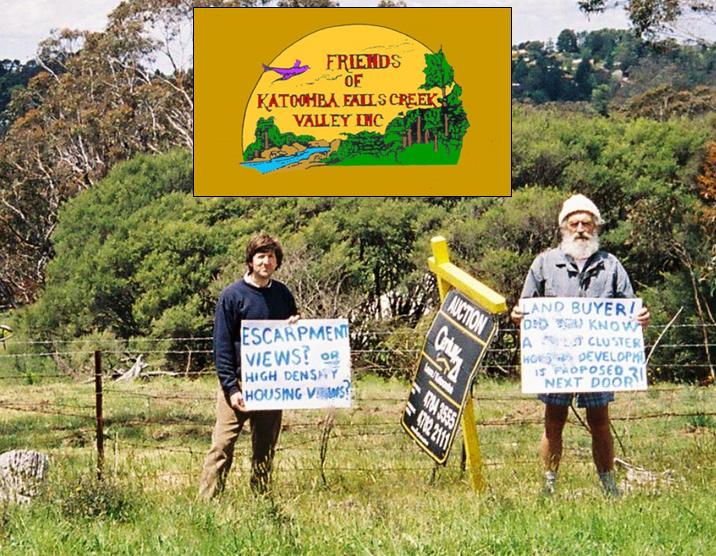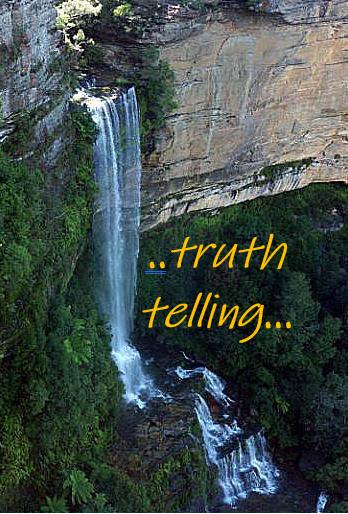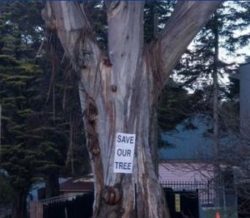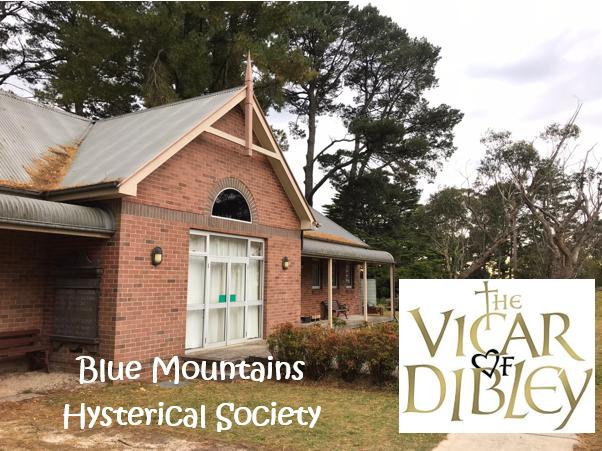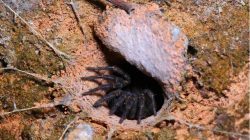Archive for the ‘Habitat Threats’ Category
Sunday, December 8th, 2013
.
Magnificent tropical wetland, Kakadu National Park lies from 230 kilometres south-east of Darwin in Australia’s Northern Territory. Kakadu’s timeless Ubirr Rock (above photo) and its wild Nadab wetland expanding to the horizon is what Kakadu is all about. This is why Kakadu is deservedly a world renowned wilderness..
.
“I’ll never forget my first sunset at Ubirr. I’d spent the afternoon enjoying the rock art, then made my way to the stone escarpment. It was beautiful looking out over the Nadab floodplain and surrounding stone country as the sun sank below the horizon. Wisps of bushfire smoke played with the pink and purple hues of the sunset.”
~ Nelson Hall, Tourism NT.
.
Kakadu finally, but only, received world heritage recognition in 1981, once the lucrative uranium ore inside it had been secured for mining. In greedy politics, it’s called a ‘quid pro quo‘.
Then Australian Prime Minister Malcolm Fraser: You black fellas can get your traditional land heritage listing now that we have legally excluded uranium mining for export inside Kakadu. So in 1981, the Ranger Uranium Mine and the adjacent Jabiluka Mine were specifically excluded when Kakadu world heritage tourism brand was launched by the Australian Government.
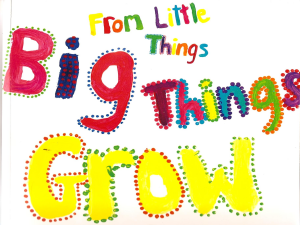 Australian Aboriginal Land Recognition
^http://www.docstoc.com/docs/81478346/1972-Aboriginal-Tent-Embassy—Election-of-Whitlam-Government Australian Aboriginal Land Recognition
^http://www.docstoc.com/docs/81478346/1972-Aboriginal-Tent-Embassy—Election-of-Whitlam-Government
.
Uranium mining has since 1981 operated inside Kakadu National Park by Energy Resources of Australia Ltd (ERA). ERA is a subsidiary of Rio Tinto, which owns and controls 68% of ERA.
ERA exports all 3,700 annual tonnes of uranium oxide extracted to electric utilities like Fukushima in Japan, and other nuclear reactors in Asia, Europe and America. The operation is subsidised by diesel fuel rebates by the Australian Government. In return, since 1981 around $200 million in royalties have been earned by the Australian Government.
So Kakadu Uranium Mining has always been a lucrative government export churn, behind the facade of the same government marketing of Kakadu being a protected, pristine World Heritage sanctuary for international tourists to wonder at, and so condone its mining.
(Ed: Kakadu’s 1981 world heritage branding, became a tourism-politic template that extrapolated to Blue Mountains branding in 2000. Since 2000, benefits have all been tourism revenue, with zero funded threatened species recovery plans).
.
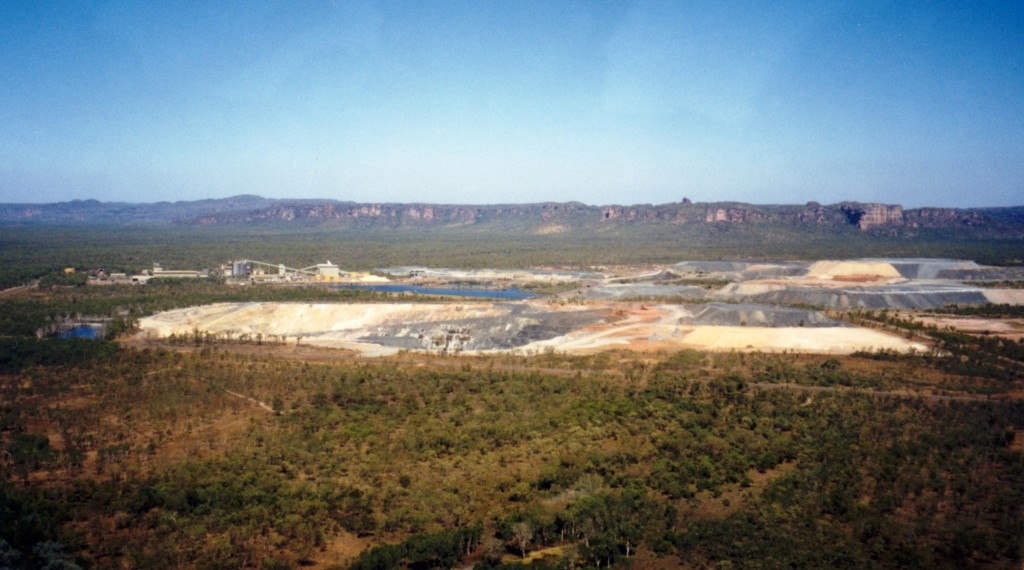 A death crater inside world heritage recognised Kakadu National Park
this toxic scar is infamously known as Rio Tinto’s Ranger Uranium Mine A death crater inside world heritage recognised Kakadu National Park
this toxic scar is infamously known as Rio Tinto’s Ranger Uranium Mine
.
Just outside the mining perimeter fences, and perhaps downstream, Kakadu National Park is one of four Australian sites included on the World Heritage List for both cultural and great natural beauty and outstanding universal values of its internationally important wetlands. Kakadu National Park was first inscribed on the World Heritage List in 1981, and was subsequently expanded and re-inscribed in 1987, and again in 1992.
.
Dec 2013: Another Rio Tinto uranium spill at Ranger in Kakadu
.
Despite Kakadu’s ecological values, yesterday another radioactive leak of an acid storage tank Ranger Uranium Mine occurred. The mine’s operator Energy Resources of Australia (ERA) said the uranium processing tank failed (exploded) about 1:00 am (Northern Territory local time) on Saturday 7th December 2013.
Up to 1.5 million litres of radioactive slurry – a mixture of mud, water, uranium ore and acid – spilled when a leaching tank split open. The material mostly spilled onto compacted earth, tarmac and drains. The company said earlier in a statement the slurry moved outside the containment area, but was captured and contained on-site.
Mine Operator, Energy Resources of Australia (ERA) denied reports of an explosion, but the tank burst with such force a crane was toppled and twisted and other infrastructure was damaged. Workers had to be evacuated and production could be shut down for months.
ERA general manager of operations Tim Eckersley released a statement yesterday that said the spill was contained on site and there was no environmental impact. Mr Eckersley said the tank was about 1450 cubic metres – capable of holding about 1.5 million litres of slurry – but the company would not say if it was full at the time.
Workers discovered a hole in the side of the 20-year-old steel tank and were evacuated before the tank burst and “a mixture of slurry escaped”. Workers were evacuated about 1am when a hole was discovered in the leaching tank. The tank then split, spilling the radioactive slurry and knocking down a crane that had been blocking the original hole.
“Containment systems stopped the flow and this has meant there is no impact to the surrounding environment,” Mr Eckersley said.
The site could be closed for up to two months as mine operators seek to contain it.
.
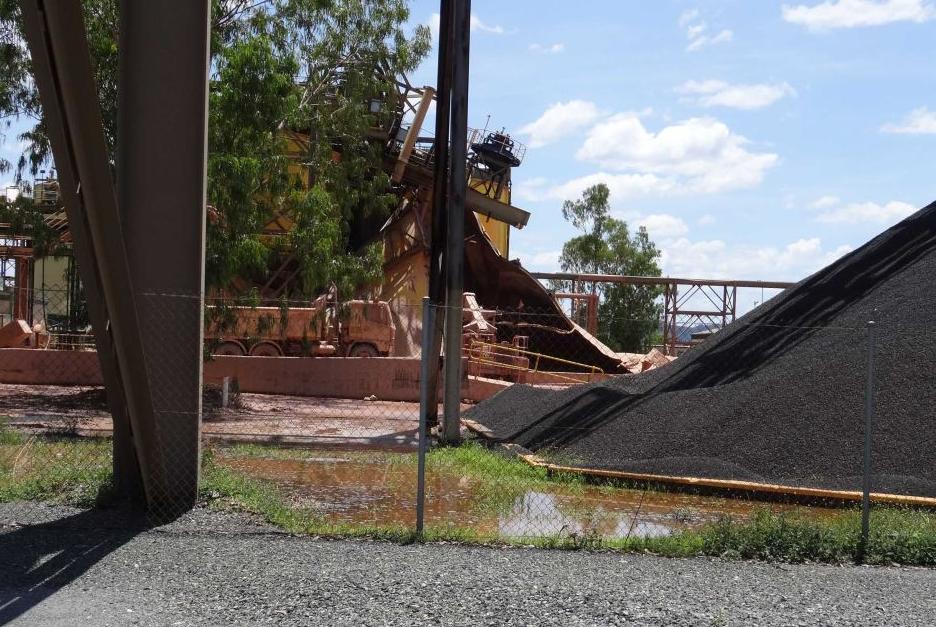 Rio Tinto Ranger Uranium Mine’s acidic radioactive pink acid slurry leaking inside Kakadu
[Source: Gundjeihmi Aboriginal Corporation, 201312, ^http://www.abc.net.au/news/2013-12-07/spill-at-nt-uranium-mine-near-kakadu/5142148] Rio Tinto Ranger Uranium Mine’s acidic radioactive pink acid slurry leaking inside Kakadu
[Source: Gundjeihmi Aboriginal Corporation, 201312, ^http://www.abc.net.au/news/2013-12-07/spill-at-nt-uranium-mine-near-kakadu/5142148]
.
Local Aboriginal Protest
.
Chief executive of the Gundjeihmi Aboriginal Corporation (GAC), Justin O’Brien, represents the traditional Mirarr people of the area.
Justin O’Brien:
“This is one of the worst nuclear incidents in Australian history and has called for an audit of the site’s facilities. “How can we trust the assurances of a company which has repeatedly failed to safely manage this highly toxic material?
This is up to a million litres of radiological material in the form of an acid exploding from a drum, bending a crane, twisting metal all around it, pouring down into stormwater drains, with 20 or so people ordered to evacuate.
What may happen next? It’s a catastrophic failure on the part of not only the operator but also the government regulators in the Northern Territory and Canberra.”
“This is nothing but a hillbilly operation, run by a hillbilly miner with hillbilly regulators. Based on the woefully inadequate government response to the previous incident, we have no confidence that this will be taken seriously enough.
Aboriginal people in communities like Mudginberri, which is about seven kilometres downstream of the Ranger mine, no longer felt safe. How can we trust the assurances of a company which has repeatedly failed to safely manage this highly toxic material?”
.
The Northern Territory Environment Centre is calling for an immediate halt to operations at the mine.
Environmental groups yesterday called on the mine to be shut down. “Ranger is ageing, failing and risking and (ERA parent company Rio Tinto) need to match their corporate rhetoric with action,” the Australian Conservation Foundation’s Dave Sweeney said.
Greens Senator Scott Ludlam said the spill should “be the last nail in this accident-prone mine”.
 The uranium processing tank contained a million litres of acidic radioactive material. The uranium processing tank contained a million litres of acidic radioactive material.
.
Recent breaches demonstrated that the mine’s claims of being the most regulated in the world were incorrect and regulators had been found wanting. Anti-nuclear campaigner Lauren Mellor said it is the third safety breach by the ERA in a month.
Lauren Mellor:
“Just within this month we’ve had an incident where a controlled vehicle was able to leave a secure area of the mine and was halfway down the Arnhem Highway before it was located,” she said. “We’ve had four barrels found in the rural area in Darwin, four barrels used to transport uranium were discarded with no explanation. The writing has been on the wall at Ranger for a long time. This disaster may well be the last nail in this accident-prone mine.”
GAC will write to the expert advisory bodies of the World Heritage Committee requesting international help, and is calling for a comprehensive external audit of what Mr O’Brien said was an endemically failing site. Environmental groups are calling for a halt to operations at the mine pending an independent audit of the structural integrity of the plant, along with a review of the impacts of operations at Ranger. ‘The time for mining a problematic and polluting mineral in a World Heritage area is over,’ said Australian Conservation Foundation spokesman Dave Sweeney. >>
.
[Sources: ‘Contamination leak at NT uranium mine’, 20131207, Sky News, ^http://www.skynews.com.au/topstories/article.aspx?id=931927; ‘Major acid leak at Kakadu uranium mine’, News Ltd, 20131207, ^http://www.news.com.au/national/major-acid-leak-at-kakadu-uranium-mine/story-fncynjr2-1226777797925; ‘Spill of contaminated material at Ranger uranium mine; locals fear for Kakadu National Park’, 20131207, ABC News, ^http://www.abc.net.au/news/2013-12-07/spill-at-nt-uranium-mine-near-kakadu/5142148; ‘Contaminated slurry spilled at Ranger Uranium Mine’, 20131207, NT News, ^http://www.ntnews.com.au/news/northern-territory/contaminated-slurry-spilled-at-ranger-uranium-mine/story-fnk0b1zt-1226777753784]
.
How has Australia’s Environment Minister responded?
.
Friend of Rio Tinto, Environment Minister Greg Hunt has declared the incident ”unacceptable” and called for an investigation. But he has not ordered suspension of operations or for this leak-plagued dangerous mine to be closed down. Hunt has only ordered a clean-up and investigation into the spillage.
Hunt is useless and tainted.
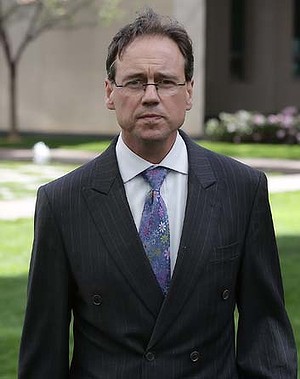 Australia’s Environment Minister Greg Hunt Australia’s Environment Minister Greg Hunt
.
Climate Change centric Greg Hunt is hopeless when it comes to his environment portfolio. He is all about a fickle climate and not that which is fast disappearing – Australia’s ecological environment. Hunt has $3.2 billion to play with yet it is all to go to climate change ‘direct action’, not protecting ecology.
.
Ranger uranium mine a “hillbilly operation”
.
<<.. The accident prompted traditional land owners to describe the Ranger uranium mine as a ”hillbilly operation” with too little regulation. The mine has a history of safety breaches and unions have raised concerns about maintenance standards at the 33-year-old operation.
The Australian Conservation Foundation and Environment Centre NT called for an immediate halt and no further expansion at Ranger. A protest at Rio Tinto subsidiary in charge of the mine – Energy Resources of Australia’s (ERA) Darwin offices was planned for Monday morning.
Uranium supplies at Ranger mine have nearly been exhausted, and ERA has been counting on a new underground expansion to keep the mine going. But it must get approval from the traditional owners of the area, the Mirarr people, for the expansion. The chief executive of the Gundjeihmi Aboriginal Corporation, which represents the Mirarr, said people no longer felt safe living near Ranger mine.
Justin O’Brien:
”This is nothing but a hillbilly operation, run by a hillbilly miner with hillbilly regulators. ‘Based on the woefully inadequate government response to the previous incident, we have no confidence that this will be taken seriously enough.”
A 20-year-old steel tank burst on Saturday morning, damaging heavy machinery and spilling acid and uranium over containment lines. No injuries were reported at the Ranger mine, where up to 1000 people work, but work stopped while the spill was cleaned up. There were still three other 20-year-old tanks holding acid at the Ranger mine, with unions concerned these too could burst.
ERA later confirmed it would launch its own investigation but was “‘confident that Kakadu National Park will not be impacted as a result of this incident” and all water tests had returned normal readings.
The Australian Manufacturing Workers Union’s Northern Territory organiser, Bryan Wilkins, called for a full independent inquiry into ERA’s maintenance program at the mine site. “‘Obviously there has been a failure in their maintenance program and that has put the workers at that mine site at risk,” Mr Wilkins said.
People well acquainted with Ranger said the incident did not reflect well on maintenance standards at the mine, which should have ensured that the acids in the tank were not able to cause such significant amounts of corrosion to cause a leak. >>
[Source: ‘Investigation as radioactive leak leaves Ranger uranium mine under a cloud’, 20131209, by Lucy Battersby and Peter Ker, Sydney Morning Herald, ^http://www.smh.com.au/federal-politics/political-news/investigation-as-radioactive-leak-leaves-ranger-uranium-mine-under-a-cloud-20131208-2yzeo.html]
.
Nov 2013: Ranger Uranium’s Mike Stone awarded Mine Manager of the Year?
.

<< Energy Resources of Australia (ERA) Mining Operations Manager Mike Stone has been awarded Mine Manager of the Year at the Australian Mining Prospect Awards following the successful completion of open cut mining at Ranger mine.
The Mine Manager of the Year Award was presented to Mr Stone at the Australian Mining Prospect Awards gala dinner in Sydney on the evening of 31 October 2013. Mr Stone was recognised for managing the completion of mining in Ranger mine’s Pit 3 in challenging conditions, while maintaining a focus on safety and productivity. >>
[Source: ‘ERA recognised with Mike Stone awarded Mine Manager of the Year’, 20131101, by Daniel Hall, Media Relations at ERA, ERA Media Releases, ^http://www.energyres.com.au/media/38_media_releases_3014.asp]
.
Tags: a mixture of slurry escaped, acidic radioactive material, Darwin, Dave Sweeney, East Alligator region of Kakadu National Park, Energy Resources of Australia, Environment Minister, ERA, GAC, Greg Hunt, Gundjeihmi Aboriginal Corporation, hillbilly operation, Jabiluka Mine, Justin O'Brien, Kakadu, Kakadu mining, Kakadu National Park, Kakadu Ubirr, Mike Stone, Mine Manager of the Year, Northern Territory, Ranger 3 Deeps, Ranger Uranium Mine, Rio Tinto, Rio Tinto Ranger Uranium Mine, rock art, Tim Eckersley, Ubirr Rock, Ubirr Rock Art
Posted in Threats from Mining | 1 Comment »
Add this post to Del.icio.us - Digg
Wednesday, November 27th, 2013
 A rare and perhaps 150 year old and healthy endemic Eucalpytus Oreades tree
Land buyer: “Hey Asplundh, it’s in the way of where I want to build a house to sell for profit.” A rare and perhaps 150 year old and healthy endemic Eucalpytus Oreades tree
Land buyer: “Hey Asplundh, it’s in the way of where I want to build a house to sell for profit.”
.
Our Investigative Journalist: “I think the E.Oreades was chopped down today (20131125) , as I heard a chainsaw coming from Loftus St.”
When 17 year olds were cut down in the prime of their life during The Great War for no reason or for someone else’s evil ends, all involved governments just sent in more to top up the slaughter with the stroke of a polly pen.
When it comes to preservating ecological life worth living, Blue Mountains Council in 2013 belongs to that same callous mindset. They continue to proclaim being a City within a World Heritage Area.
God knows why.
.
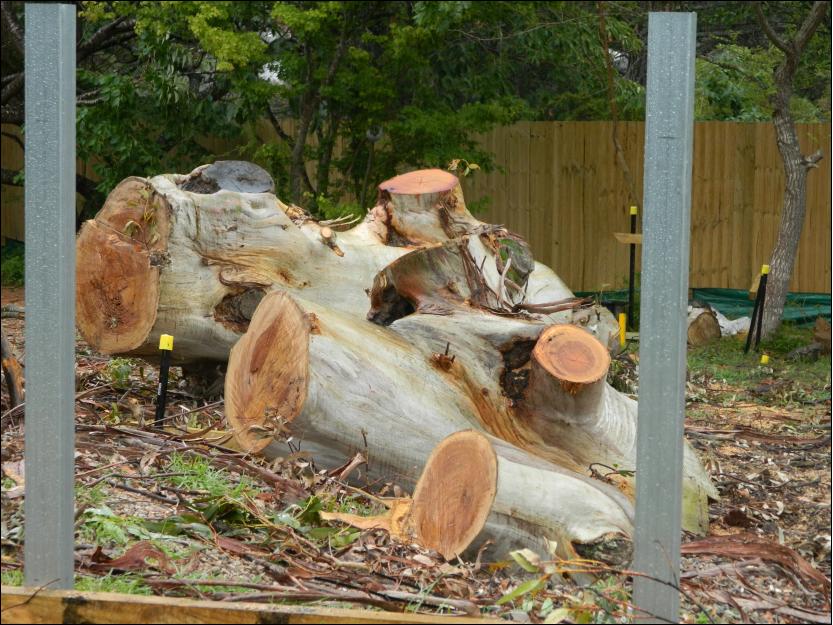 A healthy specimen of an Oreades with no signs of disease or rot.
We consider that what took place in Loftus Street Katoomba, Blue Mountains on Monday 25th November 2013, was an act of callous ecological murder
A healthy specimen of an Oreades with no signs of disease or rot.
We consider that what took place in Loftus Street Katoomba, Blue Mountains on Monday 25th November 2013, was an act of callous ecological murder
by Asplundh for one property developer’s personal greed.
.
“All that is necessary for the triumph of evil is that good men do nothing.”
.
~ Edmund Burke PC (b.1729) an Irish statesman, author, orator, political theorist and philosopher.
.
Saturday, November 16th, 2013
 Abject failure by emergency MANAGEMENT
Buena Vista Road, Winmalee, Blue Mountains, 18th October 2013 Abject failure by emergency MANAGEMENT
Buena Vista Road, Winmalee, Blue Mountains, 18th October 2013
In anyone’s assessment, except for those in charge, 193 homes lost with 109 damaged is not a firefighting success for the unlucky Blue Mountains communities of Springwood/Winmalee, Yellow Rock and Mount Victoria.
.
How often do bushfire fighters have to watch on in frustration from their fire trucks on a road towards a bushfire, knowing they are helpless with the tools they have to extinguish it?
In the case of a single house fire in an urban setting, the fire truck is the tried and tested appropriate appliance to respond. Fire fighters can readily drive up to and park right out the front and hose down a house fire. But applying this classic firefighting method to wildfires in expansive and rugged bushland with steep and often inaccessible terrain is all but useless, like square peg in round hole thinking.
Yet whenever government announces pre-election funding to bushfire fighting it is kneejerk unimaginatively more fire trucks, costing millions and fixing nothing.
It comes down to political value judgment.
.
 Water, water, in fire trucks everywhere, nor any drop to douse the fires
with apologies to English poet Samuel Taylor Coleridge in his 1798 poem, ‘The Rime of the Ancyent Marinere’.
Water, water, in fire trucks everywhere, nor any drop to douse the fires
with apologies to English poet Samuel Taylor Coleridge in his 1798 poem, ‘The Rime of the Ancyent Marinere’.
.
Many wildfires spark from lightning strikes in remote terrain and spread into hilly bushland with few access roads. More so these days, the disturbing arson fetish has become more deadly.
The consequential wildfires in inaccessible bushland country logistically render the fire truck ineffectual as the prime bushfire fighting response. Fire trucks despatched down along fire trails that are surrounded by bushland on RFS maps provide a false sense of access and ability, but they are death traps for firefighters in fire trucks during a wildfire in extreme conditions.
Just last September during the Londonderry grassfire in outer western Sydney, a fire truck along an outer urban road was overcome by flames and destroyed. It wasn’t even a fire trail.
.
 Wildfire beyond the reach of fire trucks through Windsor Downs Nature Reserve, western Sydney, September 2013
[Source: ^http://www.dailytelegraph.com.au/news/one-hell-of-a-start-to-an-early-summer-as-firestorms-sweep-across-nsw/story-fni0cx4q-1226716072987 ] Wildfire beyond the reach of fire trucks through Windsor Downs Nature Reserve, western Sydney, September 2013
[Source: ^http://www.dailytelegraph.com.au/news/one-hell-of-a-start-to-an-early-summer-as-firestorms-sweep-across-nsw/story-fni0cx4q-1226716072987 ]
.
This is where fast targeted airborne response within the first hour of ignition is more effective. The application of large quantities water bombing of a fire front is surely the preferred lead bushfire fighting response strategy. This is not to say that ground support is not needed, but the evidence is that traditional truck based ground support as the lead response strategy is simply not cutting the mustard.
But such strategy requires considerable investment and planning and requires expertise. It demands a military standard realignment of the emergency response co-ordination end-to-end from early warning systems monitoring, to ignition detection, to fast airborne response with all the latest communications technology available. Clearly this is well beyond the volunteer business-as-usual bush firefighting model that governments have lackadaisically drip fed since colonial times.
On Thursday 17th October 2013, at around 2pm, a bushfire started upwind in Springwood in the Blue Mountains in New South Wales. The fire was purportedly ignited by arcing of touching residential overhead powerlines in strong wind conditions. The Sydney Morning Herald ran a story a few days later on Sunday 20th October, that preliminary investigations had found that a tree with cables running through its branches is believed to be the seat of the fire that jumped a road then engulfed houses in Springwood, spotting over to Winmalee and Yellow Rock.
Coincidentally, a few days prior to the wildfire tragedies of Thursday 17th that separately impacted Winmalee, Yellow Rock and Mount Victoria, on 15th October New South Wales Premier Barry O’Farrell had publicly announced the arrival of an additional large firefighting Air-Crane helicopter to be leased from of all places, impoverished Greece.
Nicknamed the ‘Gypsy Lady‘, this lifesaving Erickson S-64 Air-Crane has deserved fame for its massive water bombing ability beyond any Dad’s Army Isuzu truck.
O’Farrell apparently immediately deployed it to fight bush fires according to government propaganda and photos are offered of it in action at Winmalee. But did it? So where was it and a second leased Air-Crane, ‘Elvis’, deployed on the critical multiple wildfire afternoon of Thursday 17th October?
Such government performance facts are kept secret from the public. The government’s promotional photo below of an Air-Crane water bombing bushland over Winmalee was dated Wednesday 23rd October, extinguishing left over spot fires a week later. So where is the smoke? Where there is no smoke there is probably no fire. Was this photo for the media’s benefit? The caption for this photograph reads verbatim as follows:
“A firefighter looks on as Air-Crane Elvis drops water at the Linksview Road fire near Faulconbridge, in the Blue Mountains (sic) 23/10/2103 (AAP: Lukas Coch).”
.
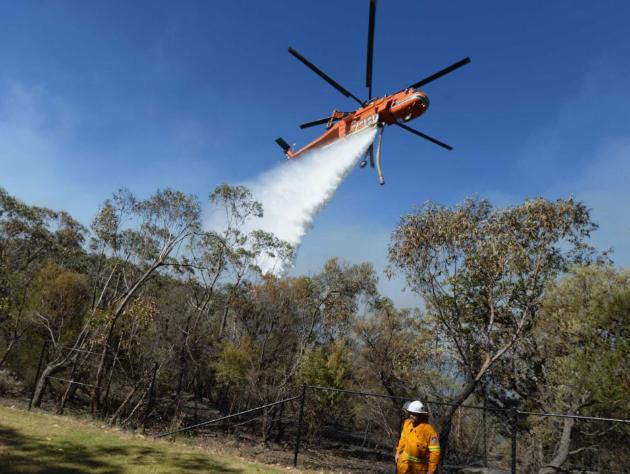 Game Changer
We can save you, if we are called in early enough.
The ‘Elvis’ Air-Crane over Winmalee, except the NSW Government’s promotional photo is dated 23rd October 2103?
[Source: ‘NSW bushfires: Crews battle to contain destructive blazes in Lithgow and Springwood’, 20131020, ABC, ^http://www.abc.net.au/news/2013-10-19/fire-crews-battle-blazes-in-lithgow-and-springwood/5033558]
Game Changer
We can save you, if we are called in early enough.
The ‘Elvis’ Air-Crane over Winmalee, except the NSW Government’s promotional photo is dated 23rd October 2103?
[Source: ‘NSW bushfires: Crews battle to contain destructive blazes in Lithgow and Springwood’, 20131020, ABC, ^http://www.abc.net.au/news/2013-10-19/fire-crews-battle-blazes-in-lithgow-and-springwood/5033558]
.
It was reported two days after Blue Mountains residents tragically lost over 200 family homes to the bushfires, that a crucial water bombing Erickson S-64 Air-Crane had been grounded at Bankstown Airport during the two day bushfire crisis, because authorities claimed they needed an American engineering and flight crew to operate it.
But then still without such American crews on Saturday 19th October, the Air-Crane was authorised to fly to Springwood, despite the absence of the US crew.
While it will now be used to assist in combatting ongoing fire hazards, the water dumper was forced to sit idle while bushfires ravaged the state on Thursday, Friday and most of yesterday. The craft is believed to be the same chopper, nicknamed ‘Ichabod‘, which was flown over on a cargo plane with the previously mentioned helicopter, ‘Gypsy Lady‘ since has been put to use – from Greece to Sydney Airport.
Previously, a qualified American team arrives with the helicopter, enabling it to operate, however the team for the Ichabod were only due to fly to Australia at a later date. As bushfires started earlier than expected, authorities were caught off-guard and forced to scramble without the use of the second craft.
The Erickson S-64 Air-Crane helicopters are able to waterbomb a fire with 10,000 litres of water and are frequently brought to Australia from the United States for the bushfire season and hot weather. But due to the Erickson Air-Crane’s absence from the fire front, ordinary choppers used by the RFS were mobilised. However it’s understand those replacement craft can only dump 300 litres of water, just 3% of that of the Erickson Air-Crane.
[Source: ‘Critical US water bomber grounded during NSW bushfire crisis’, by Yoni Bashan, State Political Reporter, The Sunday Telegraph, 20131019, ^http://www.dailytelegraph.com.au/news/nsw/critical-us-water-bomber-grounded-during-nsw-bushfire-crisis/story-fni0cx12-1226743108424]
.
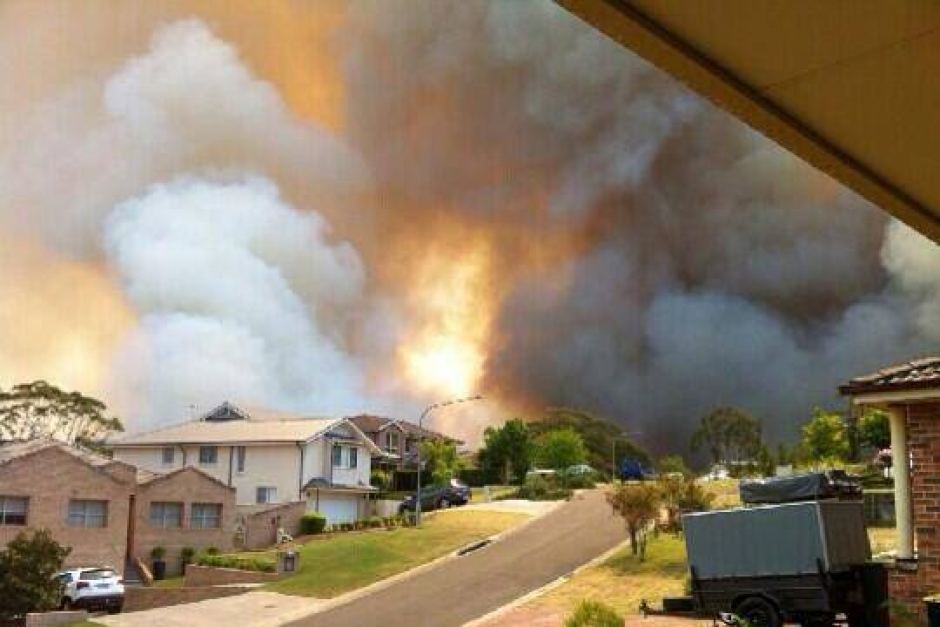 Springwood, 17th October 2013
Evacuate to where? We’re at work in the city so how can we save our valuables in time?
We have no alternate accommodation as the bloody government presumes.
We can’t afford insurance. Springwood, 17th October 2013
Evacuate to where? We’re at work in the city so how can we save our valuables in time?
We have no alternate accommodation as the bloody government presumes.
We can’t afford insurance.
.
So on the 17th October the Blue Mountains bushfires escaped ground control, leading to at least 193 homes lost and at least another 109 damaged and 3,500 hectares of bushland burnt with uncounted wildlife incinerated. The wildlife cost is always ignored.
No facts are forthcoming from the New South Wales Government about the performance of the firefighting. Why not?
- What was the estimated time of ignitions respectively at Winmalee and Yellow Rock?
- How was each wildfire reported and detected by the authorities?
- What was the elapsed time from the estimated ignition times and the respective times the RFS became alerted?
- What was the elapsed time from the estimated ignition times and the RFS response being despatched (leaving the depots)?
- What was the elapsed time from the estimated ignition times and the RFS response arriving on site to suppress the respective wildfires?
- What time was the first house impacted by wildfire?
- What time did airborne water bombing on the wildfires commence?
- What time did aircrane water bombing on the wildfires commence?
.
Such facts are not in the government’s interest to publish because it well knows that its gross under-resourcing of bushfire emergency management exposes it to negligence and cost demands.
It comes down to political value judgment.
.
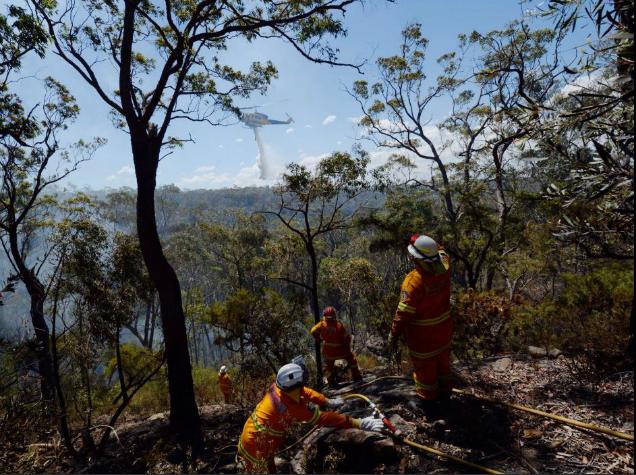 3% water capacity airborne response simply too little too late 3% water capacity airborne response simply too little too late
.
Year on year wildfire and deliberately lit hazard reductions escape control and cause the incineration of vast swathes of the remaining natural landscape. Some years people and their homes are lucky, moreso a factor of mild weather than emergency management performance. In 2009 it was Victoria’s unlucky turn.
Across Australia, bushfire detection, response and suppression is repeatedly shown to be so woeful as to be incompetent.
Government avoidance of seriously effective investment into emergency management, sees it instead resort to credibility damage control propaganda and to playing politics. It hides behind the goodwill of the volunteers, since anyone who dares criticise the performance of noble volunteers can only be publicly vilified. The government resorts to defeatist attribution of the bushfire emergency to uncontrollable Acts of God – catastrophic weather conditions in which nothing we can do would make any difference. It runs public announcements of impending Armageddon, Declares a State of Emergency as if it were 1939 Black Friday every summer and its emergency services head are instructed to do supportive drama queen performances.
Now around where the fires started there is little bushland left and little reason to stay. House values are down and people are selling up and moving off Mountains.
Government’s think their shit never stinks. Paid ambulance emergency response have a service charter to arrive on site after a 000 call within 20 minutes. But bushfire fighting has no such accountable charter. Rather the government’s emergency response duty is delegated to local volunteers charged to do their best with what they’ve got.
Typically, Rural Fire Service bushfire fighters, except for a few government paid white shirts in Homebush, are invariably unpaid volunteer members of the local community. When an emergency 000 call from a member of the public is despatched to the local brigades, the volunteers pre-occupied with their paid day jobs and have to drop everything. They are not paid to be on standby at fire brigade depots like the NSW Fire Brigades, irrespective of heightened times of high bushfire risk. The volunteers are not paid by government at all, and have to rely upon local charities for food and even for bottled water.
The last resort of the under-resourced bushfire brigades is to fight fire with fire.
.
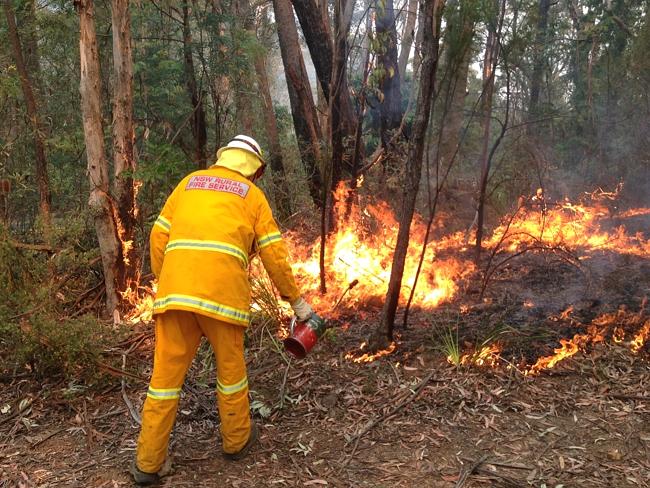 Scorched Earthing has become the last sad firefighting bastion of second class firefighters denied effective resources. Forced to fight slaughter with slaughter, or cruelty with hate. Scorched Earthing has become the last sad firefighting bastion of second class firefighters denied effective resources. Forced to fight slaughter with slaughter, or cruelty with hate.
.
The Greater Blue Mountains continues to be torched and scarred by its own custodian the National Parks and Wildlife Service. Its habitat and wildlife are being incinerated without measure or care.
Just like the mining and farming pollution impacts upon the integrity of the once Great Barrier Reef, the Greater Blue Mountains natural values are been irreversibly altered. Both the Great Barrier Reef and the Greater Blue Mountains need a cry for help and be added to UNESCO’s endangered list.
But putting Australia on an international ‘list of shame’ is but a small price. It comes down to political value judgment.
.
[The author is a licensed commercial helicopter pilot]
.
Tuesday, November 12th, 2013
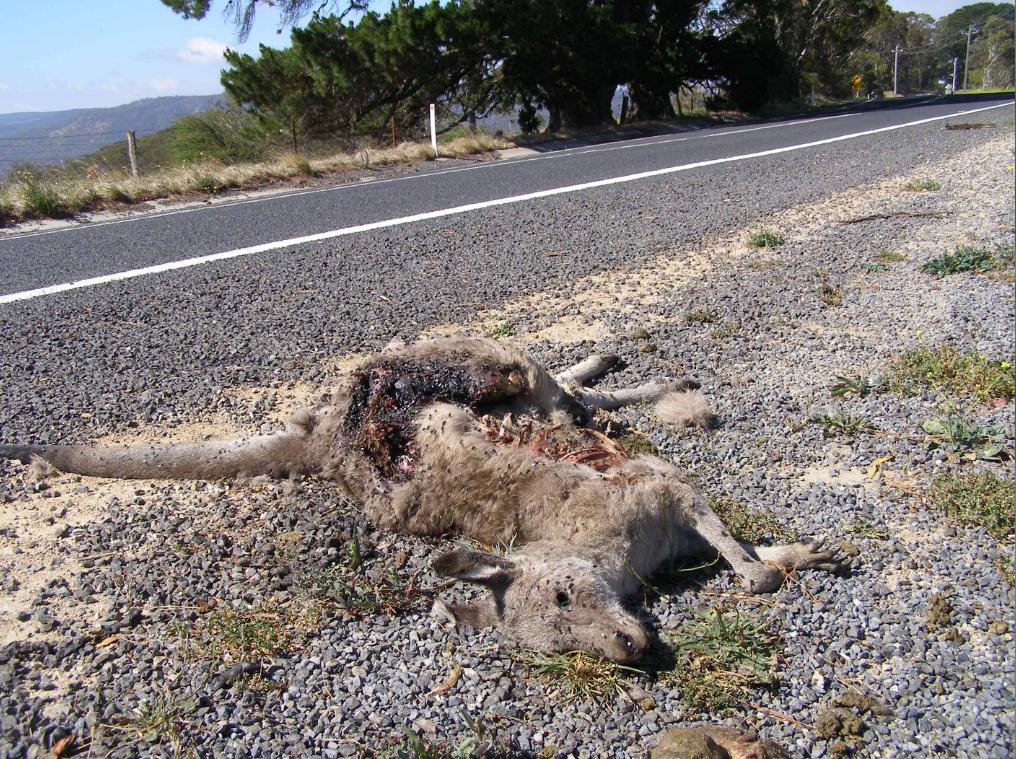 Australian roadkill on the Jenolan Caves Road to Oberon
west of the Blue Mountains, New South Wales
[Photo by Editor 20131109, © under ^Creative Commons] Australian roadkill on the Jenolan Caves Road to Oberon
west of the Blue Mountains, New South Wales
[Photo by Editor 20131109, © under ^Creative Commons]
.
Taking the tourist drive out to Oberon last weekend, we must have counted two dozen dead, mangled and fly blown Australian animals along the roadside. Kangaroos and wombats mainly; and a few feral cats and foxes.
It was a bizarre ‘Welcome to Oberon’ along the Jenolan Caves Road and then along the Duckmaloi Road into the logging and quarry town of Oberon.
We first passed by Hytec’s Austen Quarry outside Hartley which carves into the hillside to produce road making aggregate crushed rock.
.
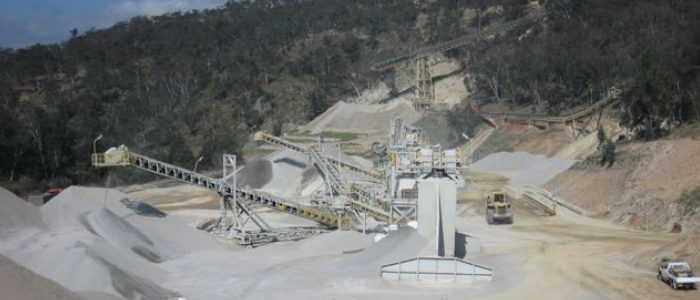 Hytec’s Austen Quarry
Jenolan Caves Road
[Source: ^http://www.hy-tec.com.au/products/Aggregates/austen.aspx] Hytec’s Austen Quarry
Jenolan Caves Road
[Source: ^http://www.hy-tec.com.au/products/Aggregates/austen.aspx]
.
We passed by this fly-blown wombat grossly mangled by the massive B-double sand trucks.
.
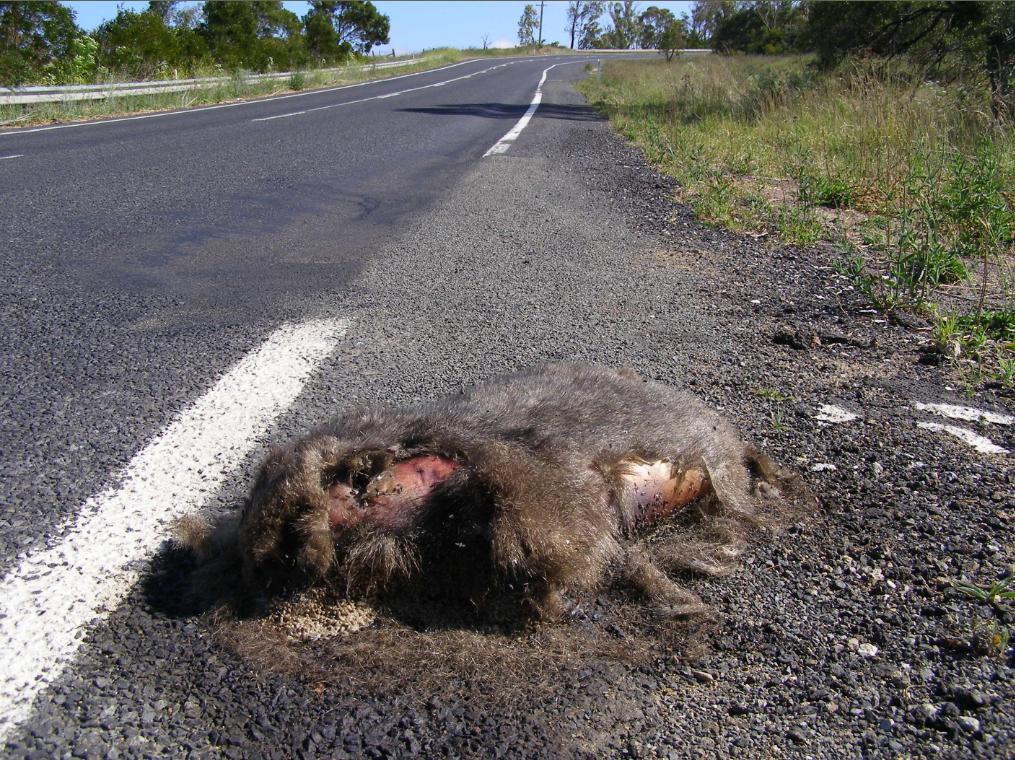 What’s left of a Wombat
Jenolan Caves Road
[Photo by Editor 20131109, © under ^Creative Commons] What’s left of a Wombat
Jenolan Caves Road
[Photo by Editor 20131109, © under ^Creative Commons]
.
The B-doubles hoon along as if racing motorbikes. We were tailgate bullied by one on the road out to Oberon. The B-double sand trucks travel through the night at speed and so the wildlife has no chance.
.
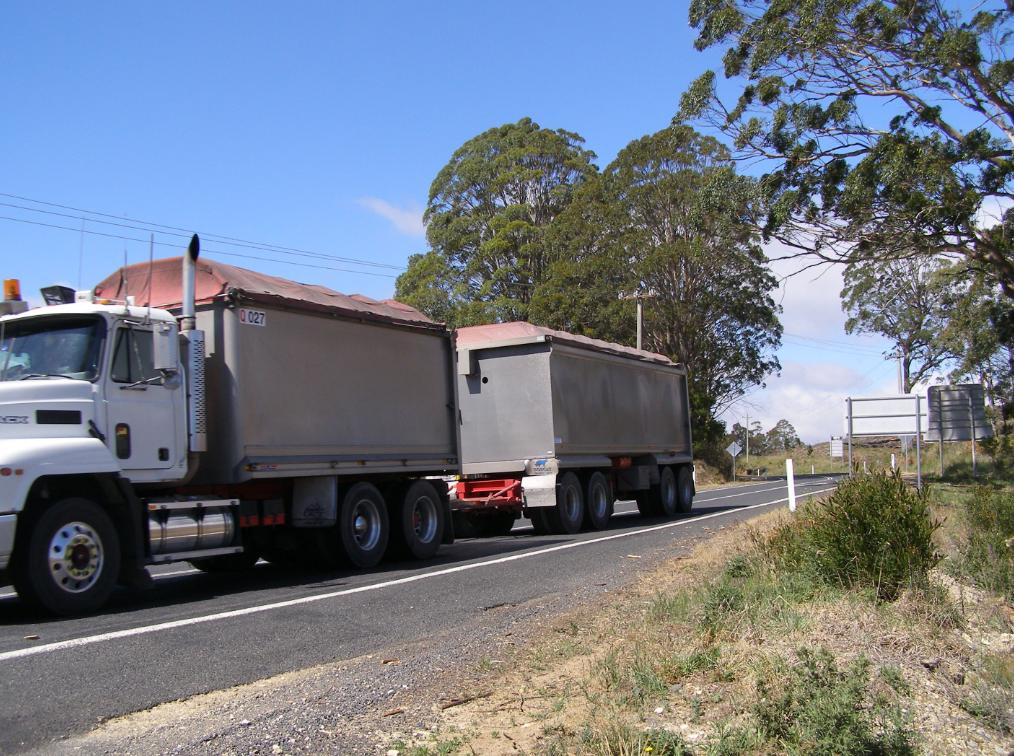 Duckmaloi Road to Oberon
[Photo by Editor 20131109, © under ^Creative Commons] Duckmaloi Road to Oberon
[Photo by Editor 20131109, © under ^Creative Commons]
.
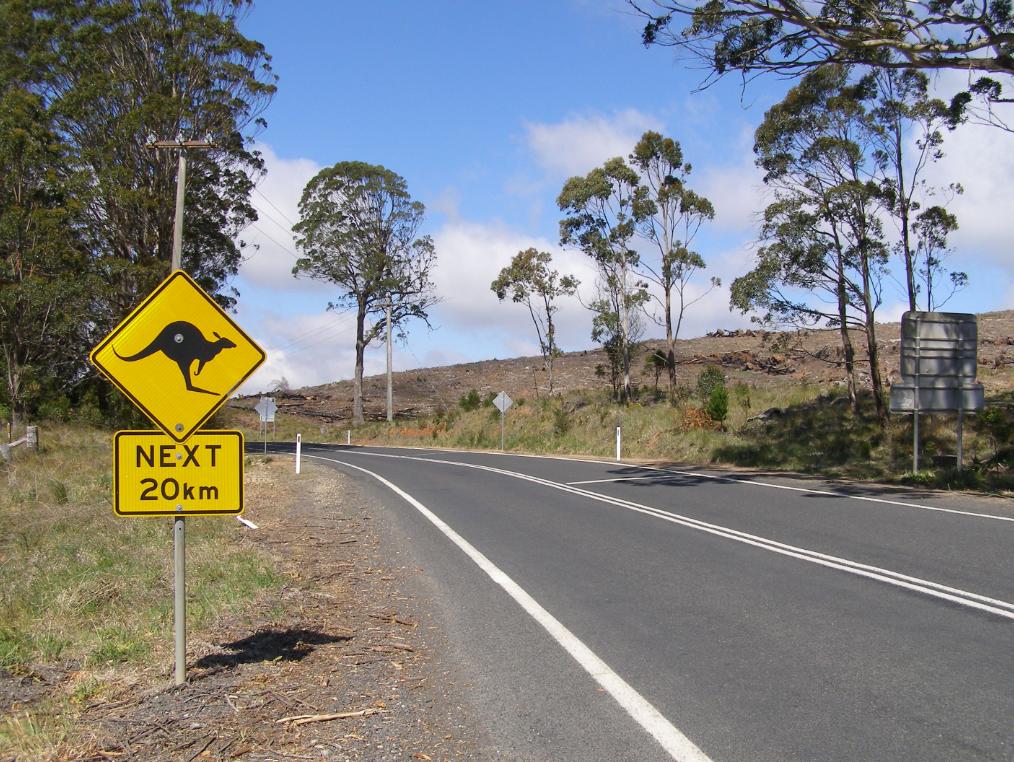 Kangaroo sign more of a token gesture
Situated on the Jenolan Caves Road opposite clearfell native forest.
[Photo by Editor 20131109, © under ^Creative Commons] Kangaroo sign more of a token gesture
Situated on the Jenolan Caves Road opposite clearfell native forest.
[Photo by Editor 20131109, © under ^Creative Commons]
.
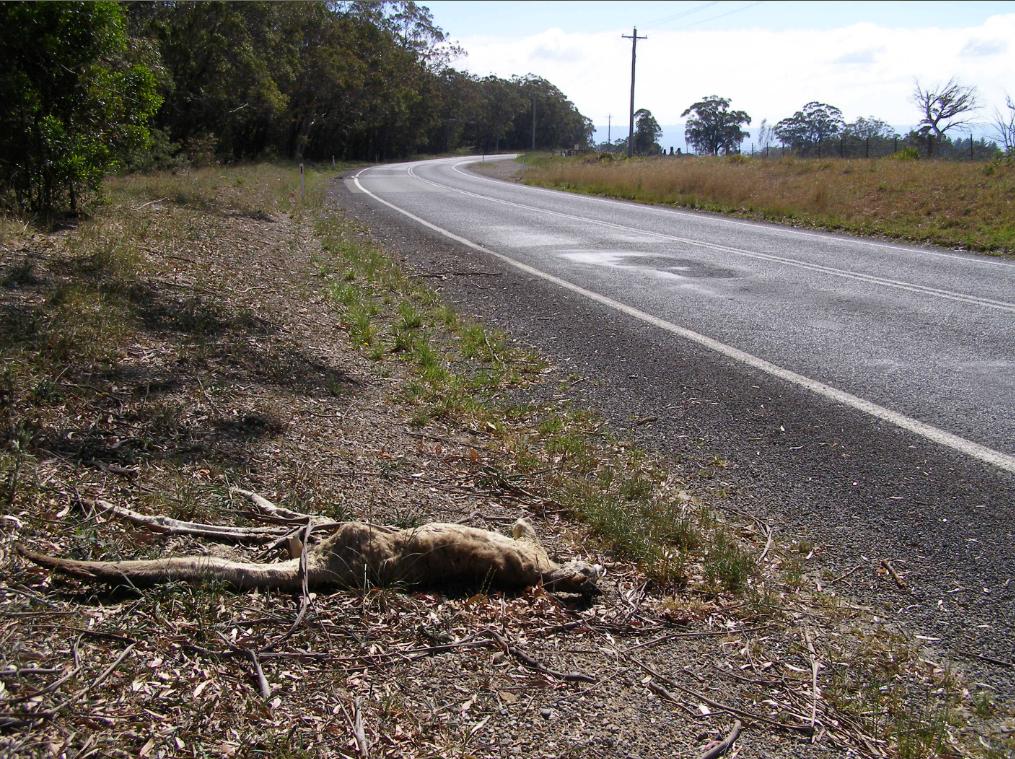 Less kangaroos next 20km
Jenolan Caves Road
[Photo by Editor 20131109, © under ^Creative Commons] Less kangaroos next 20km
Jenolan Caves Road
[Photo by Editor 20131109, © under ^Creative Commons]
.
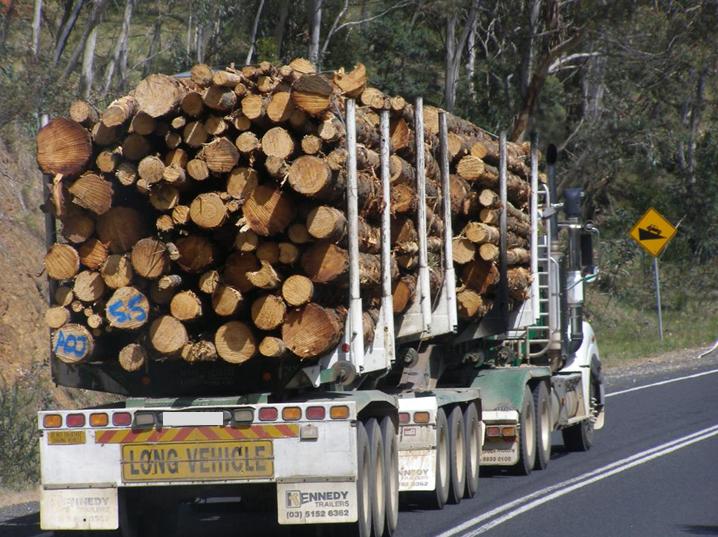 B-Double Logging Truck
Loaded up from Jenolan State Forest, along the Duckmaloi Road to Oberon’s Timber Mill
[Photo by Editor 20131109, © under ^Creative Commons] B-Double Logging Truck
Loaded up from Jenolan State Forest, along the Duckmaloi Road to Oberon’s Timber Mill
[Photo by Editor 20131109, © under ^Creative Commons]
.
One Oberon based tourism operator promotes things to do around Oberon thus:
“Explore the spectacular Blue Mountains High Country on horseback and quad bikes, ride beneath a canopy of pine forests, marvel at the unspoiled bushland, gaze into a crystal clear creek, breathe the clean mountain air.”
.
Sunday, November 10th, 2013
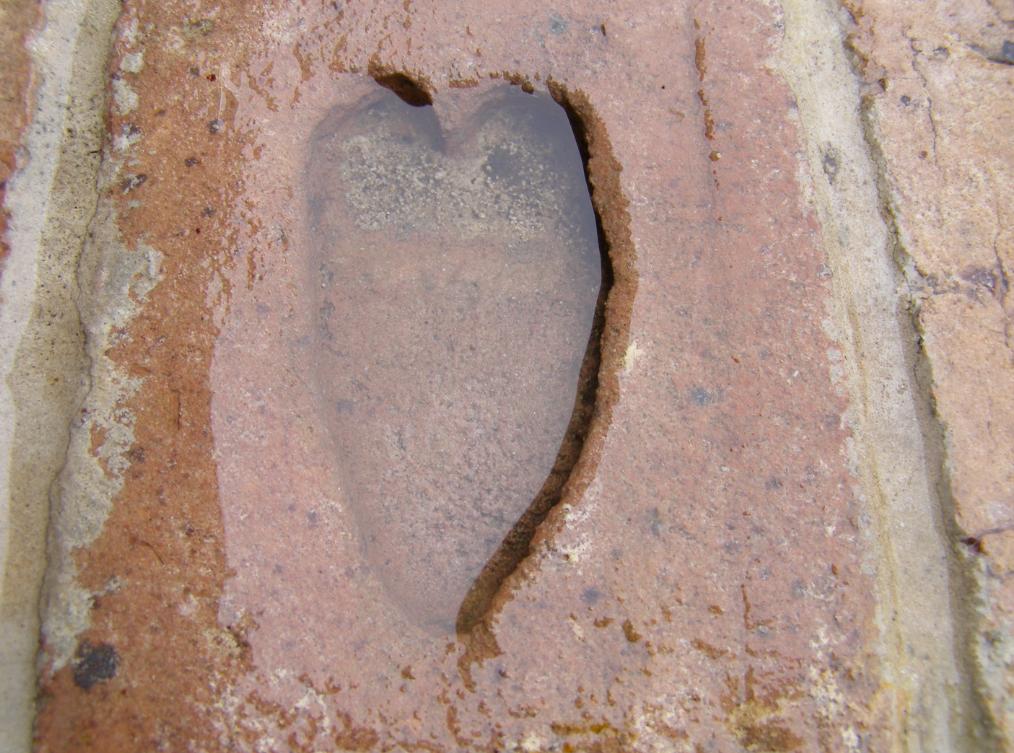 Our home’s lucky John Clew heart bricks, today full of drenching rain water
[Photo by Editor, 20131110, photo © under ^Creative Commons] Our home’s lucky John Clew heart bricks, today full of drenching rain water
[Photo by Editor, 20131110, photo © under ^Creative Commons]
.
It’s very wet. It’s actually soaking wet up here in the Blue Mountains. How welcoming are the rains? They took long enough. Poor bloody bush has been long parched out there; too parched, too tinder dry. Now the rains are over us and they are staying for while, and they can stay as long as they like.
Some dates stick in one’s mind. Friday 12th October 2012 is a date that I have personally etched into my memory. It was the day that constant snow suddenly blanketed the Upper Blue Mountains out of nowhere. The snow on the ground was a foot thick and we lost tree branches to the weight of it. It was a memorable Friday, as it no longer snows up here.
Apparently, it used to snow most winters in the Upper Blue Mountains. Living memory recalls that a few opportunistic locals even once skiied down Katoomba Street during Winter Magic.
Residents of the townships of Winmalee and Mount Victoria in the Blue Mountains will now remember Thursday 17th October 2013, but not for happy times. It was an awful day. For those affected and involved likely the worst ever. Out of nowhere separate wildfires suddenly ravaged through their communities and took away many homes and memories.
I have happened to drive past Linksview Road involuntary over recent days. Passing by incinerated homes just off the side of the road feels voyeuristic and so immoral. Luck is perhaps a curse, like pretending routine life-as-usual between others’ total loss. No way.
None of it’s fair to anyone affected or not affected but no less it about Mountains folk not knowing what to say or do for the blackened ruins down the street. Nothing wrong with outpouring and I think it is a right.
Only the firies know it could have been worse.
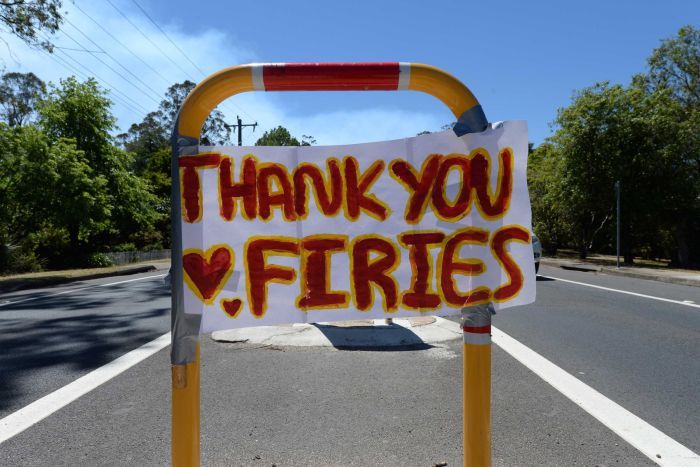
And I shouldn’t have driven down St Georges Parade yesterday on the way home, but I wanted to just to know the trauma hidden off limits by the authorities. Now its incinerated street and homes haunt me. I walked this street just after the 2006 Grose Fires, observing the hazard reduction above Lawsons Long Alley. Many new homes on a no through road ridge nestled above Blue Mountains bush. Bloody lucky then.
I awoke very early this morning realising how lucky I am as one of the 99.9% of Blue Mountains residents with a home, just as per usual. For us it is life as usual and we have rain on our roof. It is because we have a roof and a house.
Over three hundred residents this time on the morning of the 17th October did too like me, but since then they no longer do. I can’t imagine the ravage and the total loss. But I write this because catastrophe needs to be said because it is just that. All Blue Mountains people need to be affected by the incinerated homes down sealed off crime scene streets that could have been theirs.
If I had lost my home, I expect that I would not be in a state to write coherently, but I am so I choose to because I take an active interest. I witnessed wildfire threaten my home in 2001, seeing my garden hose drizzle to a horrifying dribble rendering me castratingly helpless and useless. I have taken an empathetic very personal interest in bushfire threats ever since.
My father lost his entire family records in a garage fire when I was 18. He was probably devastated at the time, but I don’t recall him expressing or showing grief because he was probably brave facing to us kids and probably because of my immature age. Over time he realised that the now and family are most important to one’s life. He has re-affirmed this over the subsequent years, with time and with a strength of family to move on. Sounds easy and simple in hindsight, but hindsight is what the memories are about, and as part of our survival instinct we tend to recall in most detail the good times, and confine the bad times to snippets.
Now that today, three week’s hence the rains are over us, I can happily stand under them and get happily soaked quite eccentrically for all it matters. So what matters at the end of the day when the sympathy has packed up and move on?
It is about why we made the choice and it was a soul thing. We live for hope and so we should. We live in the Blue Mountains because we choose because the Mountains are a special place for reasons us here know.
Bless you.
. 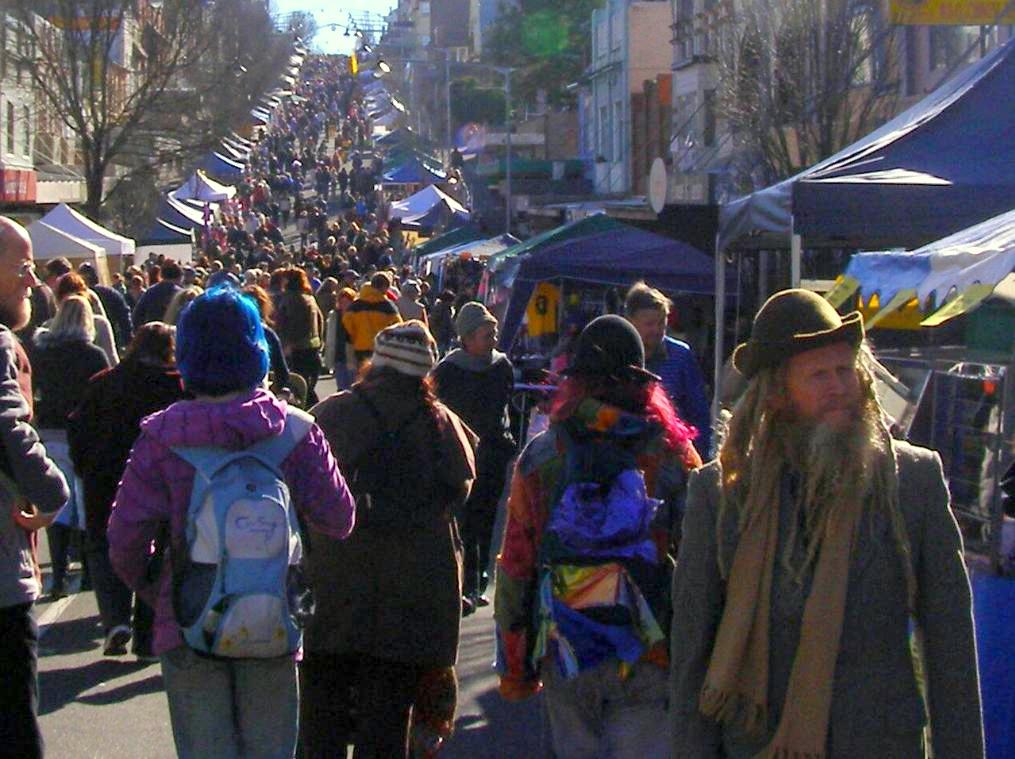 A memorable sunny day at a Blue Mountains Winter Magic
A memorable sunny day at a Blue Mountains Winter Magic
[Photo by Editor, 20080621, photo © under ^Creative Commons]
.
It is 2013 and we are to become wise, in our own time.
.
Tuesday, November 5th, 2013
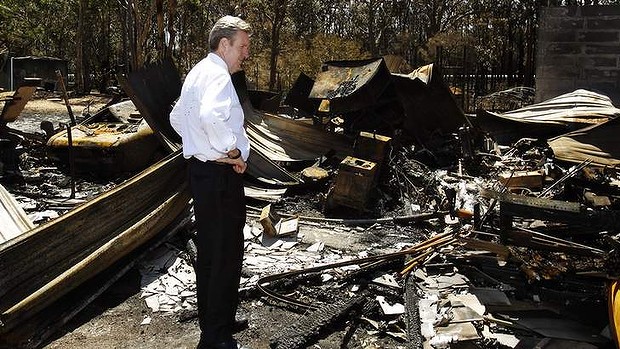 “This will be as bad as it gets”
So we kicked ass better than the Victorians in 2009,
we only had two deaths “This will be as bad as it gets”
So we kicked ass better than the Victorians in 2009,
we only had two deaths
.
The State Mine Bushfire
.
On Wednesday afternoon 16 October 2013, government Defence Force recklessly over-indulged in a live munitions exercise at the Marrangaroo army range. The range is situated on the outskirts of the town of Lithgow, New South Wales, upwind of the Greater Blue Mountains World Heritage Area. The exercised directly sparked a fire in dry grass on the range. Fanned by strong, hot, westerly winds it rapidly moved eastwards to the forested hillside on the northern side of Lithgow.
The fire spread into bushland and over the following week extended out of control burning out most of the northern region of the Blue Mountains National Park, parts of Wollemi National Park, and triggered the evacuation of most of the Lithgow region. The communities affected included Bell, Berambing, Bilpin, Clarence, Dargan, Hartley Vale, Lithgow, McKellars Park, Mount Irvine, and Mount Wilson. The fire burnt out more than 55,000 hectares (140,000 acres) between Lithgow and Bilpin.
Rural Fire Service Dad’s Army suppression delays meant that instead of waterbombing a small grassfire on the 16th, what was allowed to grow into a massive wildfire front saw fire bombing of vast hillsides in a multi-flank head burning response. Many more thousands of hectares of bushland habitat in and around the Greater Blue Mountains World Heritage Area were incinerated. But the total area of fire impact has not been made public by the RFS.
During that week fighting fires across New South Wales, two men tragically died. A 63-year-old man suffered a heart attack while fighting a fire at his home at Lake Munmorah on the Central Coast. Agricultural Pilot David Black, 43, from Trangie in the Central NSW died when his Dromader aircraft crashed while contracted to the RFS to waterbomb the Wirritin Ridge Bushfire in the Budawang National Park.
.
<< ”This will be as bad as it gets,” Rural Fire Service Commissioner Shane Fitzsimmons said. ”On days like [this], there’s a very real potential for more loss of homes and life. There’s is real potential for more homes and lives lost on Wednesday, says the NSW Rural Fire Commissioner.
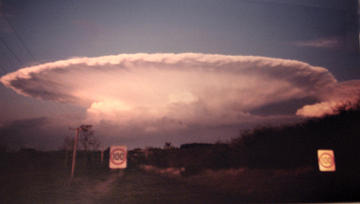 RFS Armageddon RFS Armageddon
.
Weather worse than the extremes already predicted, combined with large bushfires burning out of control, and the real potential for others to spark up, have prompted a very grim warning. The RFS had warned since the weekend about the potential devastation Wednesday’s weather could cause but the revised forecast on Tuesday was even more worrying, Mr Fitzsimmons said.
Wednesday would be hotter, drier and windier than the dire predictions previously forecast, posing a grave challenge to one of the largest firefighting contingents assembled in NSW history. They would have to battle an active 1500-kilometre fire edge in the Blue Mountains where three major fires, one at Bilpin now linked to the second at Mount Victoria and a third at Springwood, burned out of control. ”It’s a difficult, dynamic, dangerous fire-ground situation,” Mr Fitzsimmons said. >>
.
[Source: ‘This will be as bad as it gets’: Blue Mountains fire crews prepare for the worst‘, 20131022, by Nick Ralston, Emma Partridge, Sydney Morning Herald, ^http://www.smh.com.au/environment/weather/this-will-be-as-bad-as-it-gets-blue-mountains-fire-crews-prepare-for-the-worst-20131022-2vz3h.html]
.
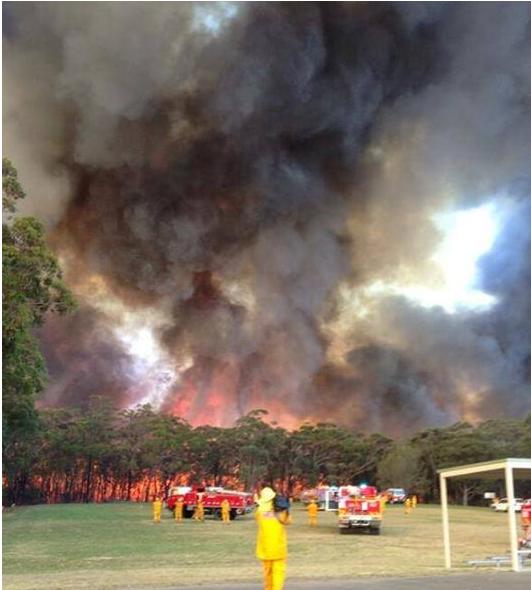 RFS Homebush doing staged PR shoot…when?
RFS Homebush doing staged PR shoot…when?
.
<< Two weeks after the worst of NSW’s bushfire emergency, the O’Farrell Government is refusing to say whether it will consider burying power lines in fire-prone areas or buy back properties razed in risky locations – key responses to the Black Saturday fires.
The Rural Fire Service says a power line started a blaze that jumped a road and then engulfed almost 200 houses at Springwood, Winmalee and Yellow Rock in the Blue Mountains on October 17.
Fallen or damaged power lines caused most of the 173 deaths in Victoria’s Black Saturday disaster of 2009. After the royal commission on those fires recommended action to address overhead power lines, the state government announced a $1 billion plan to replace them with underground cables.
That royal commission also recommended the government buy back houses in areas at extreme fire risk, and Victoria has spent $25.6 million on 116 properties. Some of the land will be sold to surrounding neighbours, who will use it as a buffer between the bush and their homes.
On Tuesday, Fairfax Media sent specific questions about power lines and property buy-backs to Emergency Services Minister Mike Gallacher. The Planning Department responded but did not address the questions, instead saying NSW had the toughest bushfire planning approvals regime in Australia.
When pressed on the need for a ministerial response, his spokesman said: ”The priority of this government at this point in time is responding to both the uncontained fires still burning across the state and the high winds this afternoon.”
When the same questions were put to Mr O’Farrell’s office on Thursday, it responded with a statement the Premier made that day in Parliament. “After events such as these there are always lessons that can be learned and applied to the future and we are determined to do so,” Mr O’Farrell had said.
”There are several investigations under way into the fires. The government will closely examine the work of those investigations.”
The statement made no mention of the lessons of Black Saturday. >>
.
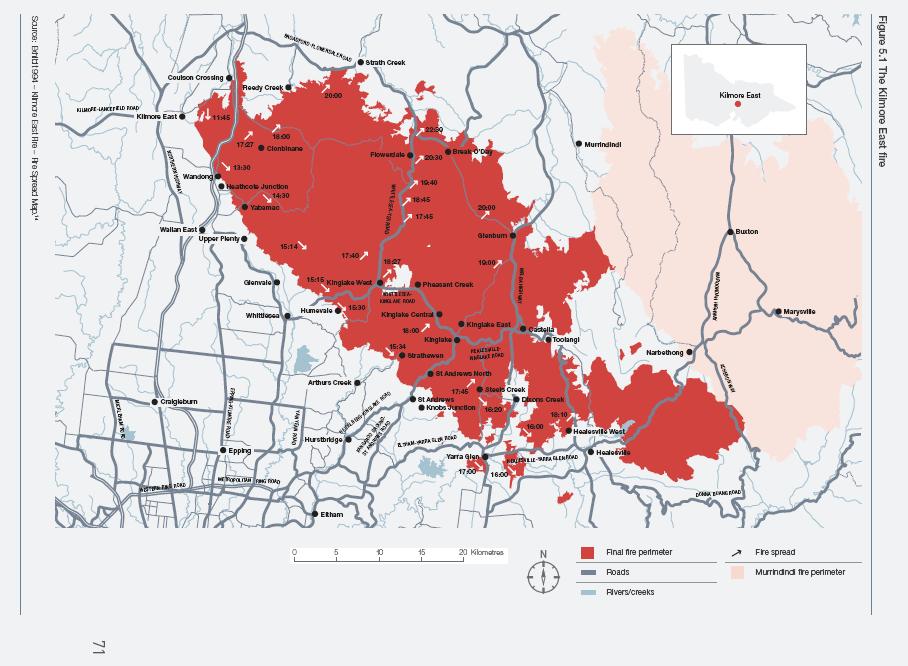 Kilmore East Fire Victoria
Started by Government neglect on 7th February 2009 Kilmore East Fire Victoria
Started by Government neglect on 7th February 2009
.
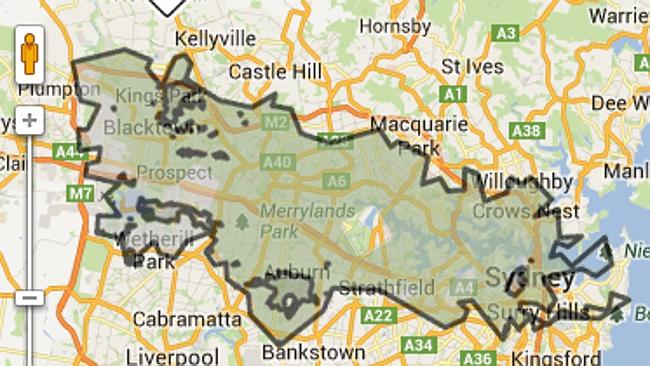 Comparative scale of the State Mine Fire (Lithgow, NSW)
Started by Government neglect on 16th October 2013
..that diverted critical firefighting resources from Winmalee Comparative scale of the State Mine Fire (Lithgow, NSW)
Started by Government neglect on 16th October 2013
..that diverted critical firefighting resources from Winmalee
.
.
[Source: ‘O’Farrell fans flames of frustration as experts warn it is time to act‘, 20131103, by Rick Feneley, News and features writer, Sydney Morning Herald, ^http://www.smh.com.au/federal-politics/political-news/ofarrell-fans-flames-of-frustration-as-experts-warn-it-is-time-to-act-20131102-2wtdq.html]
.
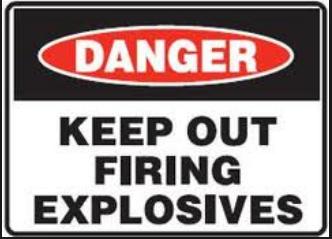
.
Saturday, October 12th, 2013
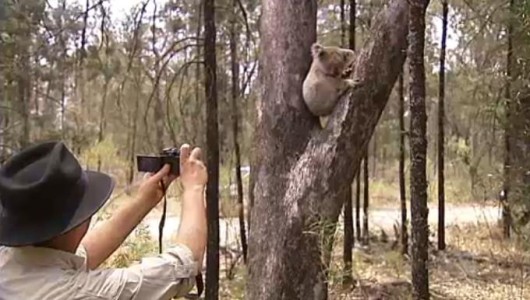 Ecological consultant David Paul with a koala found in the Leard State Forest
[Source: Photo by Tania Marshall, Front Line Action on Coal,
^http://frontlineaction.wordpress.com/] Ecological consultant David Paul with a koala found in the Leard State Forest
[Source: Photo by Tania Marshall, Front Line Action on Coal,
^http://frontlineaction.wordpress.com/]
.
Environmentalists are urging the New South Wales and Australian governments to save the Leard State Forest. They are concerned about the catastrophic impact of major mining expansion on an isolated and vulnerable koala colony in its natural habitat within the Leard State Forest.
The Leard State Forest is situated near Maules Creek within the Namoi River catchment about 10km north-east of the township of Boggabri on the North West Slopes of New South Wales, about 500km nor’-nor’-west of Sydney.
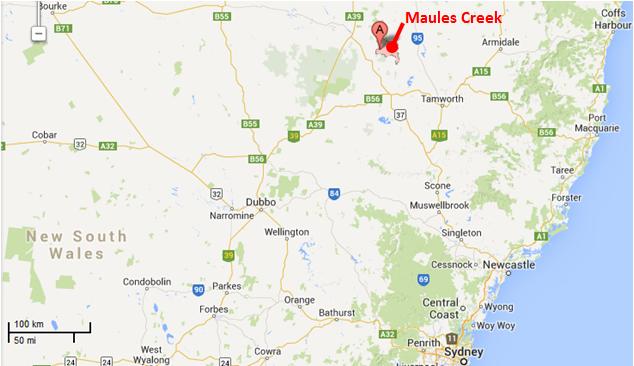 Maules Creek Mine location map
[Source: Google Maps] Maules Creek Mine location map
[Source: Google Maps]
.
The nearby town of Boggabri lies on the Namoi River, a major perennial river and floodplain within the Murray-Darling Basin. The landscape is naturally subjected to infrequent seasonal rains and widespread flooding.
.
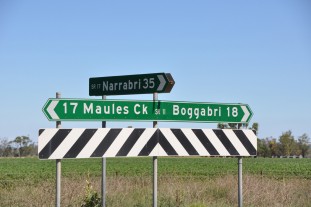 . .
The native vegetation has been naturally dominated by Box-Gum Woodland ecological communities featuring the endemic species of White Box, Pilliga Box and Bimble Box. These provide vital habitat for numerous woodland bird and microbat species and a small community of Koalas.
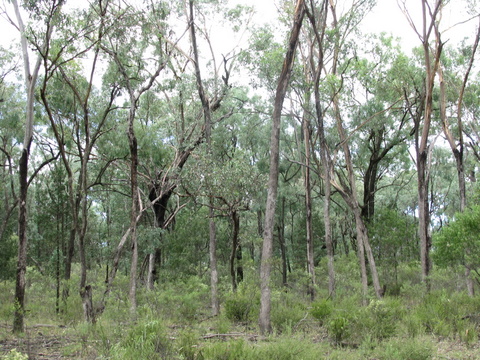 The Leard State Forest
An isolated remnant box woodland The Leard State Forest
An isolated remnant box woodland
.
The region was originally the Aboriginal land of the Kamilaroi people and their ‘place of many creeks‘. However, two hundred and twenty five years of colonial pastoral settlement and associated widespread deforestation has seen the region denuded of most native vegetation historically for sheep and wheat; and more recently for irrigated cropping, particularly water thirsty cotton.
.
 Box Woodland decimated for industrial scale cotton
The farming model is entirely artificially dependent river-diverted irrigation for export produce.
[Source: Promotional tourism advertisement by the NSW Government,
^http://www.visitnsw.com/destinations/country-nsw/moree-and-narrabri-area/gallery] Box Woodland decimated for industrial scale cotton
The farming model is entirely artificially dependent river-diverted irrigation for export produce.
[Source: Promotional tourism advertisement by the NSW Government,
^http://www.visitnsw.com/destinations/country-nsw/moree-and-narrabri-area/gallery]
.
Native habitat has been sadly reduced to a few isolated islands of land set aside as ‘State Forests’. These include the Pilliga Forest, the largest remnant temperate forest in Eastern Australia, as well as Jacks Creek, Plagyan, Rusden and Leard State Forests, as well as the rugged Mount Kaputar National Park.
Leard State Forest includes the most extensive and intact stands of the nationally listed and critically endangered Box-Gum Woodland remaining on the Australian continent and is home to nearly 400 native species of plants and animals, and includes habitat for 34 threatened species and several endangered ecological communities.
.
 Leard State Forest location map
[Source: Google Maps] Leard State Forest location map
[Source: Google Maps]
.
It’s believed as few as 20 koalas are left in the Leard State Forest, which is considered its primary habitat. The primary food source for the koalas is thought to be the Pilliga Box, Red Gums and Yellow Boxes. This Koala population is very fragile and could be significantly impacted on by the future mining plans.
Ecological consultant David Paul:
“If they are part of the same population as the Pilliga koala, then Leard is a very important area for allowing the dispersal of these animals in an east west direction. Leard Forest is a stepping stone between habitat in the Pilliga and to the east and south. While there are not many koalas there it’s a very important area to allow the dispersal of koalas in the region.”
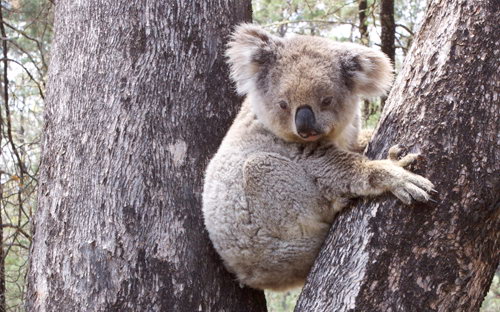 Koala in Leard State Forest
[Source: Photo by Tania Marshall, Front Line Action on Coal,
^http://frontlineaction.wordpress.com/] Koala in Leard State Forest
[Source: Photo by Tania Marshall, Front Line Action on Coal,
^http://frontlineaction.wordpress.com/]
.
.
Whitehaven Coal mining expansion into the Leard State Forest
.
<< Approval has been given for one of the biggest open-cut coal mines in the world in the state’s north-east. Whitehaven’s Maules Creek Project, near the Leard State Forest, will extract 12 million tonnes of raw coal a year.
If given the final go ahead from the Federal Government, Whitehaven expects production to start mid-2013, with operations predicted to last around 30 years.
Managing director Tony Haggarty:
“The mine will be good for the region economically and good for the state. It’s one of the best coal developments in the world. It’s a large reserve, it’s very good quality. It’s the sort of coal that is in demand in the market place, and because the reserve is large and because it has a long life, there will be a significant area of land involved.”
.
But Federal Environment Minister Tony Burke says the project will now face Commonwealth scrutiny. It will examine the mine’s potential impacts on the nearby critically endangered white box woodland.
An Environment Department spokeswoman says once the assessment is complete, it will go before Mr Burke who will consider the advice of the department, the Independent Expert Scientific Committee on possible water impacts, and any public comments.
Environmentalist Phil Spark:
“The planning commission’s approval is a blow to the endangered trees and animals that live in the forest. My biggest concern is that the environment has been totally undervalued. You just can’t destroy a forest and think it’s going to be compensated. It’s an endangered ecological community and it just can’t be replaced.”
The Maules Creek Project is about 18 kilometres north of Boggabri in the Gunnedah Basin. >>
.
[Source: ‘Go ahead for one of world’s largest coal mines’, 20121025, ^http://www.radioaustralia.net.au/international/2012-10-25/go-ahead-for-one-of-worlds-largest-coal-mines/1035960]
.
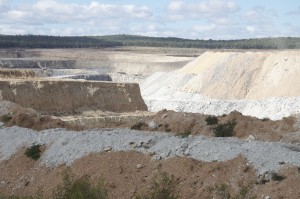 Nearby Boggabri Open Cut Coal Mine, owned by Whitehaven Coal
Saw thousands of hectares of native Box Woodland bulldozed in 2006. Nearby Boggabri Open Cut Coal Mine, owned by Whitehaven Coal
Saw thousands of hectares of native Box Woodland bulldozed in 2006.
.
Environmentalists are up in arms over a proposal to mine two thousand hectares of state forest, among it, this remnant koala habitat.
The Maules Creek Mine adjoining the Leard State Forest has received NSW government approval to expand into the forest, which will see most of the forest and its flora and fauna all but completed bulldozed into history.
Whitehaven Coal wants a new open-cut coalmine that will extract up to 13 million tonnes of coal a year to earn it $767 million. It also wants a second nearby Idemitsu Boggabri open cut mine to extract 7 million tonnes a year.
Greens Senate Candidate Cate Faehrmann:
“These approvals will literally change the face of the township of Gloucester as well as the small community of Maules Creek near Narrabri in the state’s north-west. The Maules Creek and Boggabri proposals were referred to the Federal environment minister Tony Burke because they are going to wipe out critically endangered forest which is home to many threatened species. How can any Environment Minister in their right mind approve this?
The Maules Creek coal mine alone will emit the same amount of carbon emissions each year as New Zealand during its proposed 30 year life span. This is disgraceful and it’s why communities everywhere are starting to call on the government to transition away from coal and towards a secure renewable energy future.
I have visited the site of the proposed Maules Creek coal mine recently to see the forest firsthand and saw a koala up close in the forest. Tony Burke has just approved a coal mine which will wipe out a small and vulnerable koala population
“The farmers who have been fighting coal mine proposals in Leard State Forest for years will continue to fight for the protection of their forest.”
.
Up until recently, Whitehaven Coal has been owned by multimillionnaire Nathan Tinkler. Its chief executive is Paul Flynn and one of its directors is former National Party leader Mark Vaile. In June 2013, after securing his Maule’s Creek Mine expansion approval, Tinkler sold off most of his shareholdings in Whitehaven Coal to an American profiteering investment capital firm, Farallon Funds.
Whitehaven Coal has been challenged in the courts against its proposal to mine the Leard State Forest by the Northern Inland Council for the Environment. This community based not-for-profit group has said the Federal government was wrong to approve the project. They are challenging the approval process of both the Maules Creek and nearby Idemitsu Boggabri coalmines “because of the dodgy process by which they were approved and the devastating impacts they will have”.
Whitehaven Coal chief executive Paul Flynn has insisted the court challenge to the approval of the Maules Creek mine in NSW will not stop the project and is merely a “frustrating niggle“.
Last financial year Whitehaven made a loss of $82 million.
.
[Sources: ‘Whitehaven carries on with project despite legal challenge’, 20130720, by Michael Hobbs and AAP, ^http://www.afr.com/p/national/whitehaven_carries_on_with_project_z0EwnCKbgJE1Xnrp3wJVoO; ‘Whitehaven Coal falls to $82m loss’, 20130827, by Greg Roberts, Sydney Morning Herald, ^http://news.smh.com.au/breaking-news-business/whitehaven-coal-falls-to-82m-loss-20130827-2sndo.html; ‘Tinkler sells out of Whitehaven’, 20130619, by Glenda Kwek, Sydney Morning Herald, ^http://www.smh.com.au/business/mining-and-resources/tinkler-sells-out-of-whitehaven-20130619-2ohnj.html; ‘Mining proposal puts koala habitat under threat’, 20121109, by Liv Casben, ABC media, ^http://www.abc.net.au/news/2012-11-09/mining-proposal-puts-koala-habitat-under-threat/4363234; ‘Concern for Koala’s in the Leard State Forest’, 20121112, by Kelly Fuller, ABC media, ^http://www.abc.net.au/local/audio/2012/11/12/3630754.htm; ‘Labor turns back on NSW environment’, 20130211, by Cate Faerhmann, ^http://catefaehrmann.org/tag/mining/]
.
Listen to ABC Radio interview with Ecologist David Paul in 2012:
 (Click icon and play audio on the ABC Radio website, turn up volume to listen)
[Source: ‘Concern for Koala’s in the Leard State Forest’, 20121112, radio interview by Kelly Fuller, Morning Show, ABC Radio New England NSW,
^http://www.abc.net.au/local/audio/2012/11/12/3630754.htm] (Click icon and play audio on the ABC Radio website, turn up volume to listen)
[Source: ‘Concern for Koala’s in the Leard State Forest’, 20121112, radio interview by Kelly Fuller, Morning Show, ABC Radio New England NSW,
^http://www.abc.net.au/local/audio/2012/11/12/3630754.htm]
.
.
.
Further Reading:
.
[1] Front Line Action on Coal, (a community-based environmental activist group), ^http://frontlineaction.wordpress.com/
.
[2] ‘Koala habitats in danger as bushland areas are bulldozed‘, 20121011, Sydney Morning Herald, ^http://www.smh.com.au/environment/animals/koala-habitats-in-danger-as-bushland-areas-are-bulldozed-20121011-27fjw.html
.
[3] ‘Mining proposal puts koala habitat under threat‘, 20121109, ABC News, ^http://www.abc.net.au/news/2012-11-09/mining-proposal-puts-koala-habitat-under-threat/4363234
.
[4] ‘Burke approves huge gas and coal plans‘, 20130212, by Ben Cubby, Paddy Manning, Sydney Morning Herald, ^http://www.smh.com.au/federal-politics/political-news/burke-approves-huge-gas-and-coal-plans-20130211-2e8vh.html
.
<< A clutch of big coal and coal seam gas projects, including the controversial Whitehaven mine near Narrabri in NSW, have been approved by the federal Environment Minister, Tony Burke. He signed conditional approvals for Whitehaven’s Maules Creek mine, planned for the Leard State Forest, Idemitsu’s neighbouring Boggabri coalmine expansion, and a coal seam gas development planned by AGL for Gloucester in NSW.
Together, the three resources projects would have a huge carbon footprint of 47 million tonnes of greenhouse gases a year – about 8 per cent of Australia’s total emissions – according to environmental impact assessments. Whitehaven, part-owned by embattled coal baron Nathan Tinkler, was subject to a damaging hoax when anti-coal campaigner Jonathan Moylan issued a fake press release claiming ANZ had stopped funding the project, causing a temporary drop in the miner’s share price. His protest is being investigated by the Australian Securities and Investments Commission.
The mining projects had all been approved at state level. Mr Burke’s signature was seen as the final obstacle to development.
”Of all the decisions I have ever made, this is the one where I have the least idea of whether the projects are going to go ahead,” he said. ”For all three projects there are substantial issues.”
Some of the hurdles yet to be overcome are the preservation of a ”biodiversity corridor” in the Leard Forest to allow koalas and other vulnerable animals to survive, high quality offsets to partially compensate for sections of the forest which would be cut down, and a hydrogeological survey around Gloucester.
Mr Burke compared Monday’s decision to the approval granted by former environment minister Malcolm Turnbull to the proposed Gunns pulp mill in Tasmania. That process involved a series of separate ”modules” that stretched the approvals process out for years, before the project was finally canned.
Asked if his coal and coal seam gas decisions then amounted to ”Clayton’s approvals”, Mr Burke said: ”It’s a completely fair criticism. I would have much preferred to do things in the usual way, and give clear approvals or rejections. Unfortunately the NSW government chose to leak commercial information, and caused this process.”
Mr Burke was referring to a confidential letter from him to the NSW government, obtained by Fairfax Media, flagging his intention to approve the Whitehaven mine late last year. He said NSW would be excluded from the further approvals process because the letter was leaked.
Also on Monday, the NSW government granted conditional approval for an expansion of BHP Billiton’s Dendrobium coalmine south-west of Sydney. Five longwall coal panels will be dug beneath Sydney’s drinking water catchment, with some surface damage expected to eight ”upland swamps” – rare ecosystems that support a variety of plants, birds and amphibians.
The managing director of Whitehaven, Tony Haggarty, welcomed the approval and said: ”Notwithstanding the stringent environmental conditions which have been placed on the project and the difficult coal market at present, this is an excellent project and Whitehaven will be seeking to bring it into production as soon as possible.”
An AGL spokeswoman also welcomed the approval and said it would work on satisfying the 36 conditions on matters of national environmental significance and protection of groundwater.
”Conservationists are furious about Minister Burke’s decision,” said the chief executive of the Nature Conservation Council of NSW, Pepe Clarke. ”Leard Forest is a rich natural habitat, teeming with life, and this decision marks the death knell of this extraordinary area.” The NSW Greens said the series of approvals made for ”a very black day for the environment in NSW”. >>
.
[5] ‘Whitehaven Coal gets Maules Creek green light‘, 20130926, The Australian Newspaper, ^http://www.theaustralian.com.au/business/mining-energy/whitehaven-coal-gets-maules-creek-green-light/story-e6frg9df-1226727476581]
.
[6] ‘Leighton to build Maules Creek rail loop‘, 20131010, Sydney Morning Herald, ^http://news.smh.com.au/breaking-news-business/leighton-to-build-maules-creek-rail-loop-20131010-2v9ic.html,
.
<< Whitehaven Coal has contracted Leighton Holdings to build a rail loop for its $766 million Maules Creek project in NSW. The rail loop is a key part of the coal mine’s infrastructure and an important milestone in its construction, Whitehaven said.
The mine, in the Gunnedah basin in the state’s north, is slated to begin production in the first quarter of calendar 2015, providing 10.5 million tonnes of saleable thermal and coking coal.
Environmentalists are fighting the federal government’s approval of the mine in the Federal Court, with a decision expected in November. >>
.
[7] Maules Creek Community Council, ^http://maulescreek.org/
.
 Community protest meeting against local coal mining
[Source: ‘Sea of hands support gasfield free region at Tamworth public meeting’, 20130226,
^http://maulescreek.org/news/page/3/] Community protest meeting against local coal mining
[Source: ‘Sea of hands support gasfield free region at Tamworth public meeting’, 20130226,
^http://maulescreek.org/news/page/3/]
.
[8] Whitehaven Coal – the dirty face of the Coal Industry

Whitehaven Jobs: << With a workforce which will surpass 1000 people in the next five years, we are the place for opportunity. We are independent, we have a high quality portfolio of producing mines and we are developing three of Australia’s most significant new coal projects.
We want smart, committed, motivated people who value a dynamic culture and quick decision making. We want people who value being part of a community and achieving goals. At Whitehaven people can make a difference, and do make a difference. Our operations are currently underpinned by our Narrabri underground longwall operation and our three existing open cut mines – all situated in NSW’s Gunnedah Basin.
Our Maules Creek Project, also in the Gunnedah Basin, was fully approved in July 2013 and will provide significant and exciting career opportunities across a wide range of mining-related professions. Maules Creek is one of the last major undeveloped and significant multi-seam coal deposits in New South Wales and is expected to sustain a potential project life in excess of 30 years. It is approved to extract up to 13 Mt of coal per annum and rail 12.4 Mt of product from the site in any calendar year.>>
[Source: <<http://www.whitehavencoal.com.au/careers.cfm]
.
[8] ‘Icons under threat‘, Nature Conservation Council of New South Wales, 2012, report, ^http://nccnsw.org.au/content/icons-under-threat
.
Saturday, October 5th, 2013
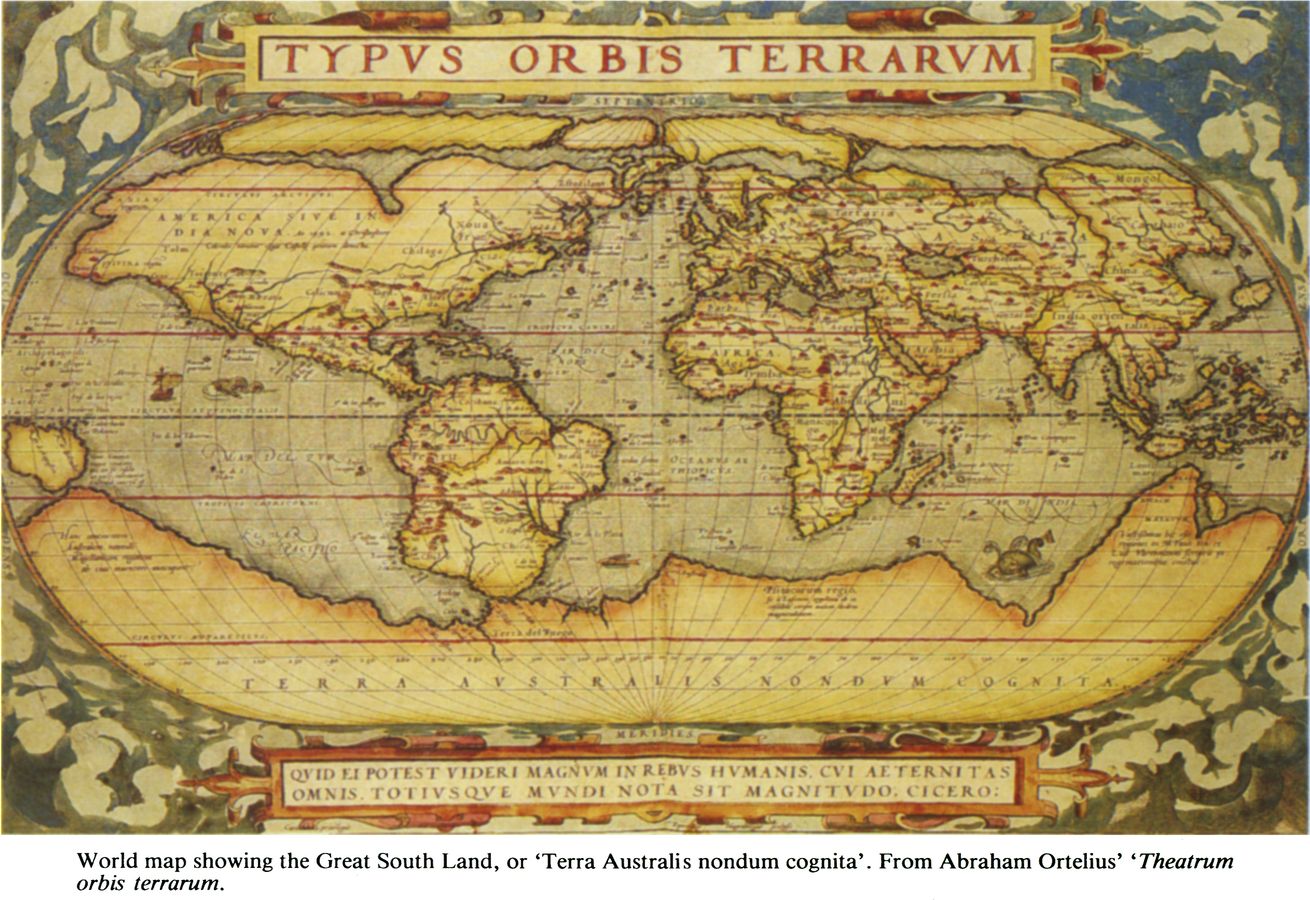 ‘Typus Orbis Terrarum’ (Spherical Model of the Earth) of 1564
[Source: ‘World map showing the Great South Land, or ‘Terra Australis nondum cognita’, from Abraham Ortelius’ ‘Theatrum orbis terrarum’, No 41 Autumn 1988, The La Trobe Journal State Library of Victoria, State Government of Victoria Australia, ^http://www3.slv.vic.gov.au/latrobejournal/issue/latrobe-41/fig-latrobe-41P001a.html]
Click image to enlarge ‘Typus Orbis Terrarum’ (Spherical Model of the Earth) of 1564
[Source: ‘World map showing the Great South Land, or ‘Terra Australis nondum cognita’, from Abraham Ortelius’ ‘Theatrum orbis terrarum’, No 41 Autumn 1988, The La Trobe Journal State Library of Victoria, State Government of Victoria Australia, ^http://www3.slv.vic.gov.au/latrobejournal/issue/latrobe-41/fig-latrobe-41P001a.html]
Click image to enlarge
.
This is one of the earliest walled atlases of the world by Flemish cartographer and geographer, Abraham Ortelius (b.1527). Ortelius is generally recognized as the creator of the first modern atlas, here adopting the Theatrum Orbis Terrarum or “Theatre of the World” projected interpretation. Across the south of the world he extrapolated a then yet to be discovered ‘Terra Australis nondum cognita’ or Great South Land not yet known’.
Once known, it became abbreviated to ‘Terra Australis’ and subsequently named by British explorer Matthew Flinders’ simply as ‘Australia’. Since then Australians have abbreviated everything possible..
Ortelius is also believed to be the first to imagine that the continents were joined together before drifting to their present positions. So perhaps Ortelius should be a scholar of Gondwana.
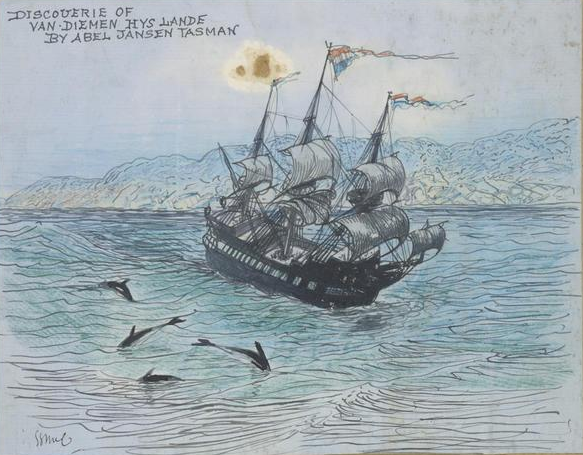 . .
The following extracts have been taken from the Introduction in a 1987 book by Ian G. Read entitled, ‘The Bush – a Guide to the Vegetated Landscapes of Australia‘.. Images have been added by our Editor.
<< Australia is a vast land of never-ending horizons, broken back ranges, eerily silent forests and golden, blue shores. It is also a land of vast suburban sprawls, monotonous cropping country, eroded hillsides and long lanes of traffic leading to the beach. It is a land that has been populated for millennia and a land that has attracted new populations to its more equable southern and eastern fringes. It is both an old and a new Australia.
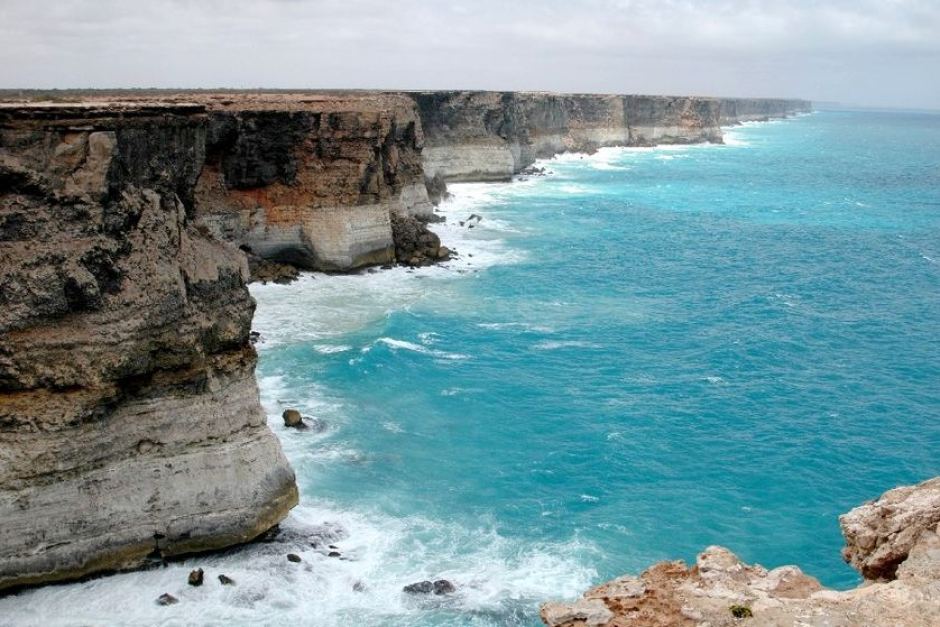 Perhaps each Australian would gain from pilgrimage to the infinite horizon of The Great Australian Bight,
to grasp its awe and so with it, their own smallness.
[Ed: Note the curvature of the horizon. The planet is not as unlimited as many babyboomers imagine.] Perhaps each Australian would gain from pilgrimage to the infinite horizon of The Great Australian Bight,
to grasp its awe and so with it, their own smallness.
[Ed: Note the curvature of the horizon. The planet is not as unlimited as many babyboomers imagine.]
.
To the European man Australia as firstly a mere conception, a conjecture on the earliest world maps, the Great South Land. With exploration and discovery the land grew in the minds of explorers, the map makers and the ruling classes of Europe. To Asian man Australia was a reality, particularly its northern shores which were frequently visited by peoples of the islands to the north. To the Aborigines Australia was home and has been for at least 40,000 years.
Europeans, being the latest of mankind’s races to make contact with Australia are, due to their history and traditions, the least capable of understanding the land. Having only settled here for seven or eight generations many European types have yet to establish a connection with the land beyond that of viewing the land as a resource. The last two hundred (and twenty five) years has seen the land undergo significant changes, the changes of occupation. No longer is the land in a state of balance but a state of change based on economic development.
.
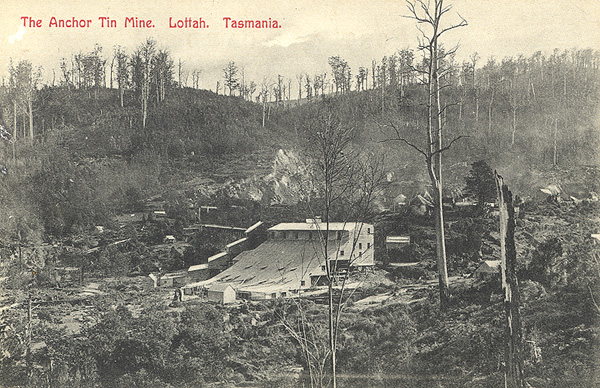 Anchor Tin Mine , Lottah Tasmania
(Tasmaniana Library, State Library of Tasmania) Anchor Tin Mine , Lottah Tasmania
(Tasmaniana Library, State Library of Tasmania)
.
As this development gained momentum during the twentieth century the new arrivals became less dependent on the land for their existence. There was a shift of values regarding the land; values which alienated the land further from the occupiers. European man did not see the land as nurturer but as a resource to be exploited. >>
.
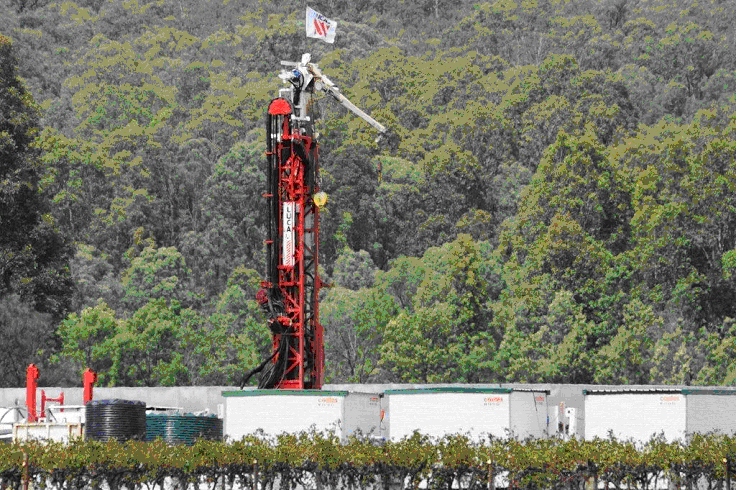 Coal Seam Gas Mining in the Hunter Valley north of Sydney, 2012
^http://www.huntervalleyprotectionalliance.com/HVPA_brochure_20120109.html Coal Seam Gas Mining in the Hunter Valley north of Sydney, 2012
^http://www.huntervalleyprotectionalliance.com/HVPA_brochure_20120109.html
.
<<..The history of European occupation of the lands of Australia is not a good one. Through fear, ignorance, greed or power much of the land has suffered. It is thought that the earliest settlers wanted to create landscape similar to where they came from so they imported planst and animals and a way of life in order to tame what they thought was a harsh environment.
.
 El Questro Station, The Kimberleys
Some things don’t change. The cattle station was initially established in 1903.
In 1991, an English aristocrat bought the cattle station and developed into a tourist park, and continues to run 8,000 head of cattle.
[Source: ^http://www.broomeandthekimberley.com.au/gibb-river-road-and-gorges/] El Questro Station, The Kimberleys
Some things don’t change. The cattle station was initially established in 1903.
In 1991, an English aristocrat bought the cattle station and developed into a tourist park, and continues to run 8,000 head of cattle.
[Source: ^http://www.broomeandthekimberley.com.au/gibb-river-road-and-gorges/]
.
The discovery of gold brought (considerably) more people who came to exploit the land without returning anything to it; needless to say many remained on the goldfields though most returned to coastal cities or to whence they came. Then followed a period of pastoral expansion whereby over ten per cent of the land was cleared of trees and another sixty per cent was grazed, browsed and trampled by sheep and cattle. Even today vast tracts of country are being cleared of vegetation.
.
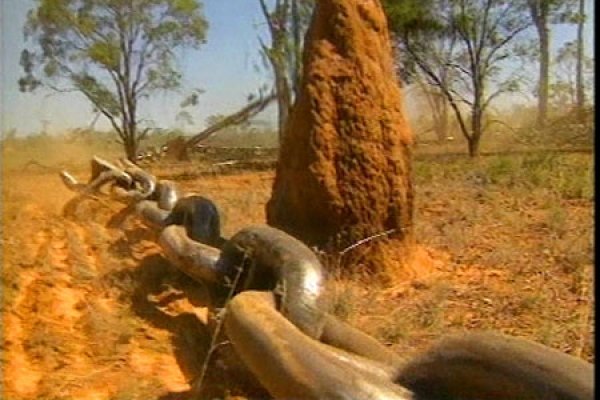 Queensland Premier Campbell Newman’s government this week passed the Vegetation Management Framework Amendment Bill, which effectively removes protection of two million hectares of mature and recovering bushland.
[Source: ‘Newman takes axe to Abbott’s Direct Action, and Qld bush’, 20130524, by Giles Parkinson, Australian and New Guinea Fishes Association – QLD Inc. ^http://www.angfaqld.org.au/aqp/blog/2013/05/24/newman-takes-axe-to-abbotts-direct-action-and-qld-bush/] Queensland Premier Campbell Newman’s government this week passed the Vegetation Management Framework Amendment Bill, which effectively removes protection of two million hectares of mature and recovering bushland.
[Source: ‘Newman takes axe to Abbott’s Direct Action, and Qld bush’, 20130524, by Giles Parkinson, Australian and New Guinea Fishes Association – QLD Inc. ^http://www.angfaqld.org.au/aqp/blog/2013/05/24/newman-takes-axe-to-abbotts-direct-action-and-qld-bush/]
.
Much of the Brigalow country of Queensland is disappearing; plans have been put forward to clear parts of the Western Division of New South Wales for crops while the conservative elements in Western Australia had plans to clear the Yilgarn and Dundas wilderness so that the sons of farmers could work their own properties. All this was (and is?) to occur in the face of unreliable rainfall, rising salt in the soil (which makes the land useless in less than three generations), and a loss of countless habitats.
.
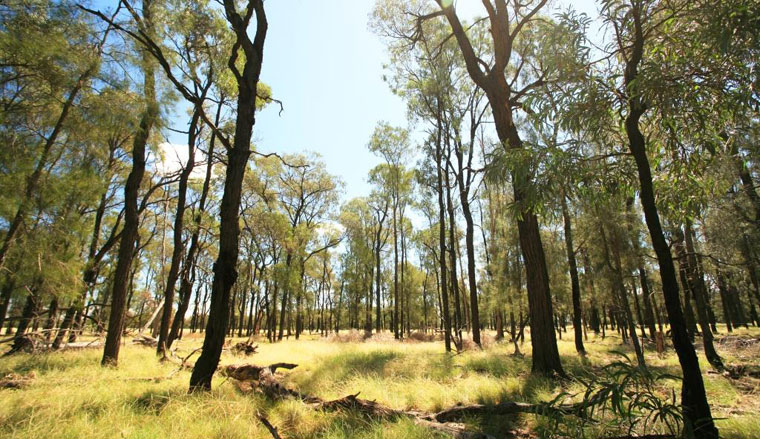 Brigalow Ecological Community (Acacia harpophylla) Brigalow Ecological Community (Acacia harpophylla)
Listed as Endangered in 2001 due to two centuries of continuing mass deforestation for cropping and pasture.
^http://www.environment.gov.au/cgi-bin/sprat/public/publicshowcommunity.pl?id=28&status=Endangered
.
Though fear of the land may have been reduced over the last two hundred (and twenty five) years ignorance, greed or power are still potent masters, and each still operates to alienate the European from his or her new landscapes.
The landscape does not evoke fear or alienation, the mind does. The landscape can trigger those feelings but it is the perception of that landscape through ignorance or a lack of understanding that induces a negative reaction.
Changing one’s perception requires more than changing one’s mind but it may be that understanding and interpreting what is being seen is all that is required. Interpretation need not be involved because all it requires is a knowledge of its components. It’s how these components fit together that is complicated. To be able to put a name to something greatly assists in interpreting what is being seen while to actually discover that named ‘something’ is an experience in itself. >>
.
~ Extracts from the Introduction, in The Bush – a Guide to the Vegetated Landscapes of Australia, by Ian G. Read, 1987, Reed Books, pp. 9-10.
.
Perceived character of natural areas (1978):
.
<<
- Less than 4% see natural areas as bad, ugly, noisy, dirty, repulsive, evil, wasteful, boring, dead, uninviting, dull, useless or depressing
- Between 4% and 25% see natural areas as bleak, dangerous or fragile
- Between 25% and 50% see natural areas as happy, friendly, sacred, huge, roadless or pure
- More than 50% see natural areas as good, remote, alive, exciting, unique, wild, challenging, inspiring, valuable, restful, unspoiled, free, beautiful or natural. >>
.
~ Based upon research for a doctoral thesis by Keith McKenry, contained in Mosley, 1978.
.
“Too far South for spices and too close to the rim of the earth to be inhabited by anything but freaks and monsters.”
.
~ Abel Tasman upon sighting the West Coast of Tasmania in November 1642.
.
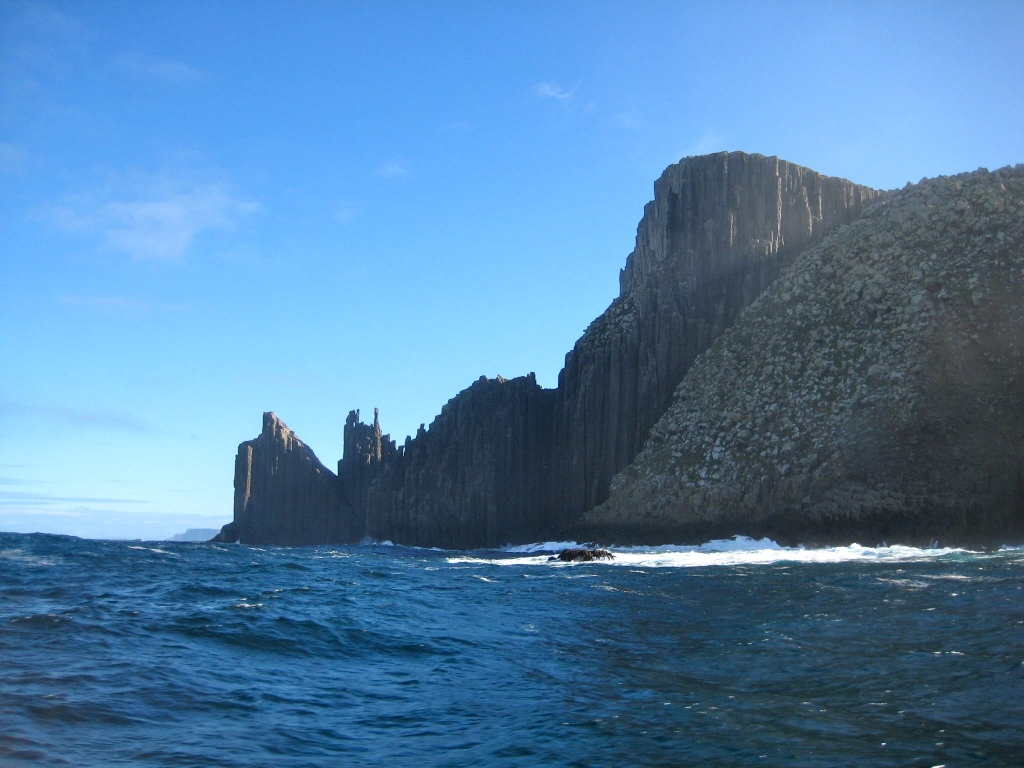 Photograph of Cape Point Raoul, South West Wilderness, Tasmania.
[Source: Jane Stadler, ^http://www.australian-cultural-atlas.info/CAA/listing.php?id=72] Photograph of Cape Point Raoul, South West Wilderness, Tasmania.
[Source: Jane Stadler, ^http://www.australian-cultural-atlas.info/CAA/listing.php?id=72]
.
<< Australia’s most important environmental case, ‘the Franklin Dams Case’, a successful High Court challenge, influenced the outcome of a federal election and resulted in World Heritage nomination for south-west Tasmania in 1982.
Enlarged in 1989 to cover 20 per cent of Tasmania’s land area, the Tasmanian Wilderness World Heritage Area (1.38 million hectares) failed to protect the tall eucalypt forests excluded by a convoluted eastern boundary. These ancient forests are being progressively decimated by industrial forestry, despite an international outcry. The south-west is recognised as one of the earth’s few remaining extensive temperate wilderness areas, a significant tourist drawcard posing fresh challenges as increasing visitor numbers impact on its outstanding natural values. >>
..
[Source: South West, by Helen Gee, 2006, in Companion to Tasmanian History, Centre for Tasmanian Historical Studies, University of Tasmania,^http://www.utas.edu.au/library/companion_to_tasmanian_history/S/South%20west.htm]
.
<< Overall, Australia has lost nearly 40% of its forests, but much of the remaining native vegetation is highly fragmented. As European colonists expanded in the late 18th and the early 19th centuries, deforestation occurred mainly on the most fertile soils nearest to the coast.
In the 1950s, south-western Western Australia was largely cleared for wheat production, subsequently leading to its designation as a Global Biodiversity Hotspot given its high number of endemic plant species and rapid clearing rates. Since the 1970s, the greatest rates of forest clearance have been in south-eastern Queensland and northern New South Wales, although Victoria is the most cleared state.
Today, degradation is occurring in the largely forested tropical north due to rapidly expanding invasive weed species and altered fire regimes. Without clear policies to regenerate degraded forests and protect existing tracts at a massive scale, Australia stands to lose a large proportion of its remaining endemic biodiversity. The most important implications of the degree to which Australian forests have disappeared or been degraded are that management must emphasize the maintenance of existing primary forest patches, as well as focus on the regeneration of matrix areas between fragments to increase native habitat area, connectivity and ecosystem functions. >>
.
[Source: ‘Little left to lose: deforestation and forest degradation in Australia since European colonization’, by Corey J. A. Bradshaw, School of Earth and Environmental Sciences, The University of Adelaide, article in Journal of Plant Ecology, Vol. 5, Issue 1, pp. 109-120, ^http://jpe.oxfordjournals.org/content/5/1/109.full]
.
.
.
Further Reading:
.
[1] ‘A Terrible Beauty‘, by Richard Flanagan, , Melbourne, 1985, Greenhouse Publications
.
[2] ‘The South West Book’, by Helen Gee & Janet Fenton,1978, Melbourne, William Collins and the Australian Conservation Foundation
.
[3] ‘Trampled Wilderness’, by R & K Gowlland, Devonport, 1975, C.L. Richmond and Sons Pty Ltd
.
[4] ‘History of West and South-West Tasmania’, by T Jetson & R Ely, Hobart, 1995, Tasmanian Historical Research Association
.
[5] ‘Patriots: Defending Australia’s Natural Heritage‘, by William J. Lines, 2006, University of Queensland Press
.
[6] ‘The Biggest Estate on Earth: How Aborigines Made Australia‘, by Bill Gammage, 2012, Allen & Unwin
.
[7] ‘Woodland to Weeds – Southern Queensland Brigalow Belt‘, by Nita C. Lester, 2008, 2 ed, Brisbane: Copyright Publishing
.
[8] ‘ The Discovery of Tasmania: Journal Extracts from the Expeditions of Abel Janszoon Tasman and Marc-Joseph Marion Dufresne, 1642 & 1772‘, rare book by Abel Tasman.
.
|
|
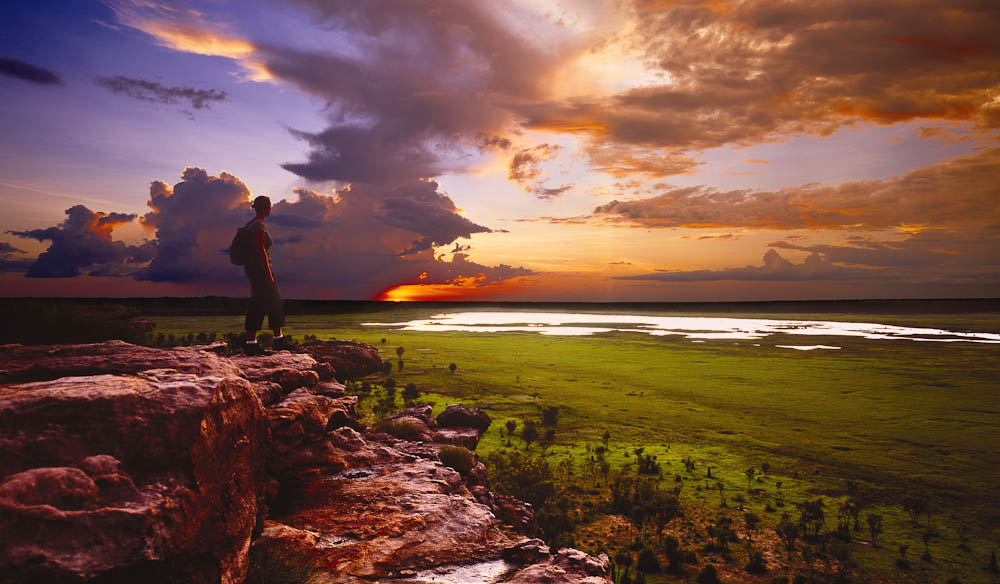 Kakadu Sublime
Drive about 120 km south-east of Darwin and find this.
(Click image to enlarge)
Kakadu Sublime
Drive about 120 km south-east of Darwin and find this.
(Click image to enlarge) Australian Aboriginal Land Recognition
^http://www.docstoc.com/docs/81478346/1972-Aboriginal-Tent-Embassy—Election-of-Whitlam-Government
Australian Aboriginal Land Recognition
^http://www.docstoc.com/docs/81478346/1972-Aboriginal-Tent-Embassy—Election-of-Whitlam-Government
 A death crater inside world heritage recognised Kakadu National Park
this toxic scar is infamously known as Rio Tinto’s Ranger Uranium Mine
A death crater inside world heritage recognised Kakadu National Park
this toxic scar is infamously known as Rio Tinto’s Ranger Uranium Mine
 Rio Tinto Ranger Uranium Mine’s acidic radioactive pink acid slurry leaking inside Kakadu
[Source: Gundjeihmi Aboriginal Corporation, 201312, ^http://www.abc.net.au/news/2013-12-07/spill-at-nt-uranium-mine-near-kakadu/5142148]
Rio Tinto Ranger Uranium Mine’s acidic radioactive pink acid slurry leaking inside Kakadu
[Source: Gundjeihmi Aboriginal Corporation, 201312, ^http://www.abc.net.au/news/2013-12-07/spill-at-nt-uranium-mine-near-kakadu/5142148]
 The uranium processing tank contained a million litres of acidic radioactive material.
The uranium processing tank contained a million litres of acidic radioactive material.
 Australia’s Environment Minister Greg Hunt
Australia’s Environment Minister Greg Hunt

 A rare and perhaps 150 year old and healthy endemic Eucalpytus Oreades tree
Land buyer: “Hey Asplundh, it’s in the way of where I want to build a house to sell for profit.”
A rare and perhaps 150 year old and healthy endemic Eucalpytus Oreades tree
Land buyer: “Hey Asplundh, it’s in the way of where I want to build a house to sell for profit.”















































